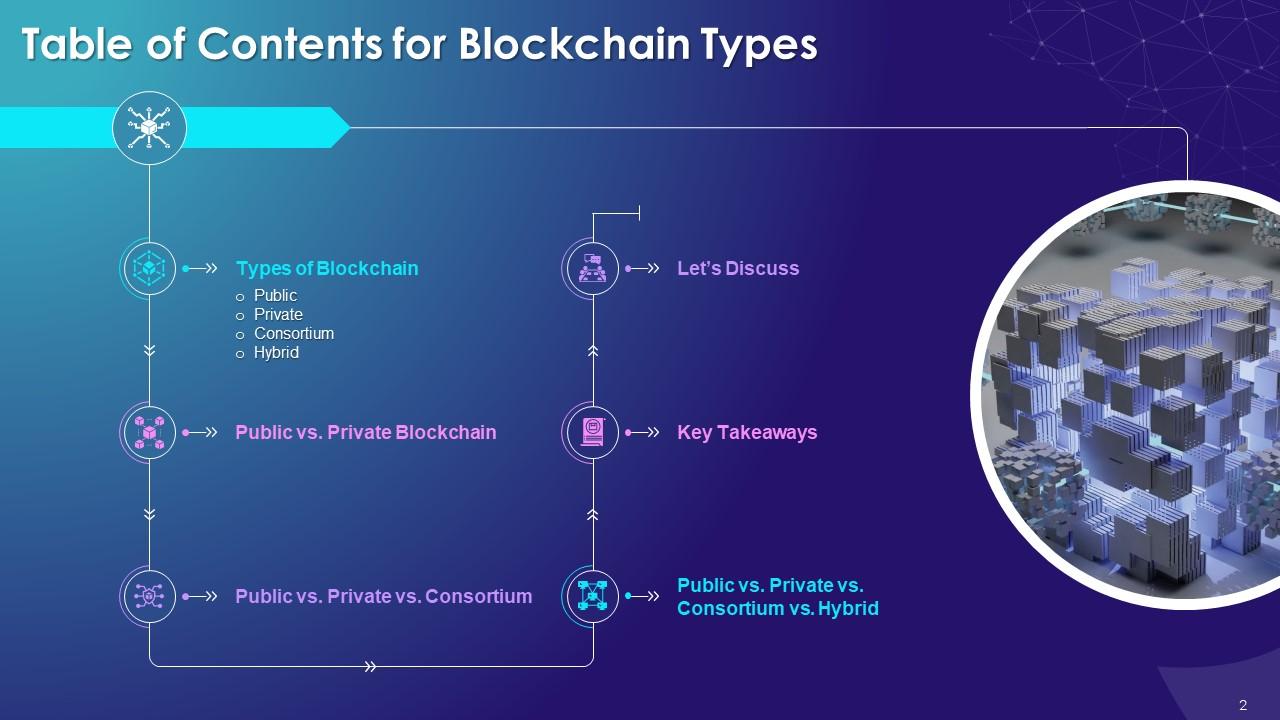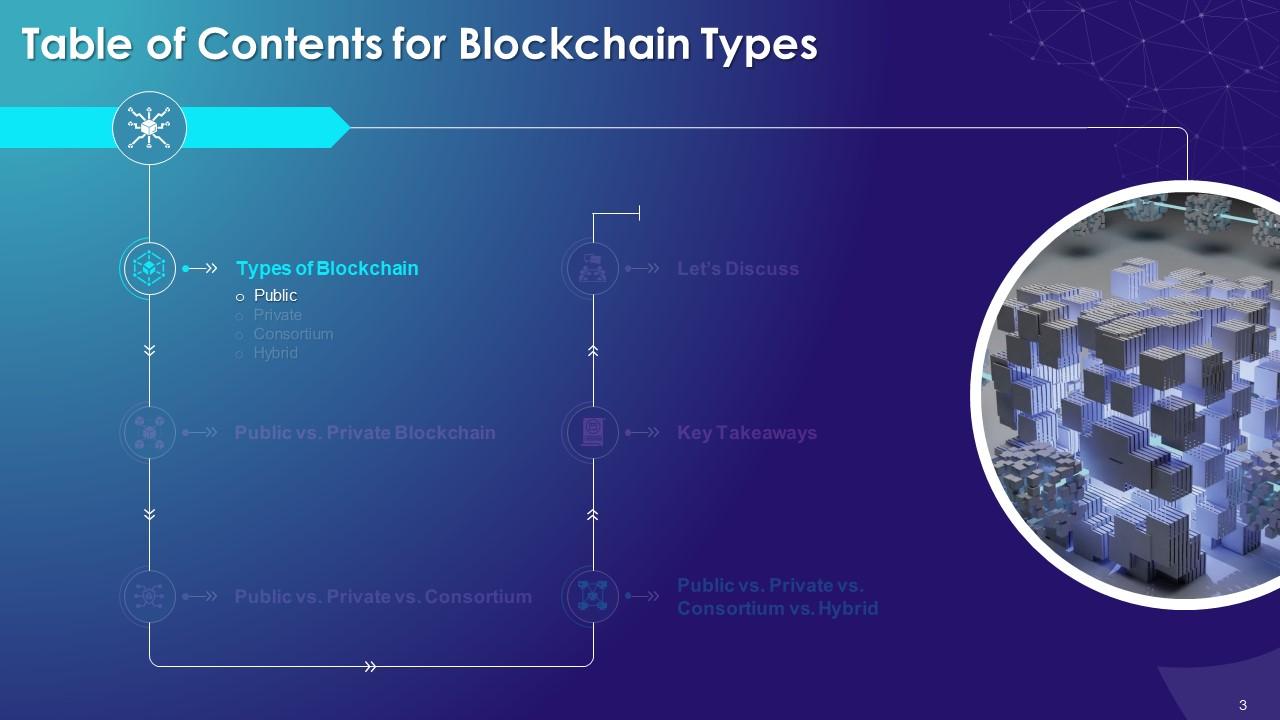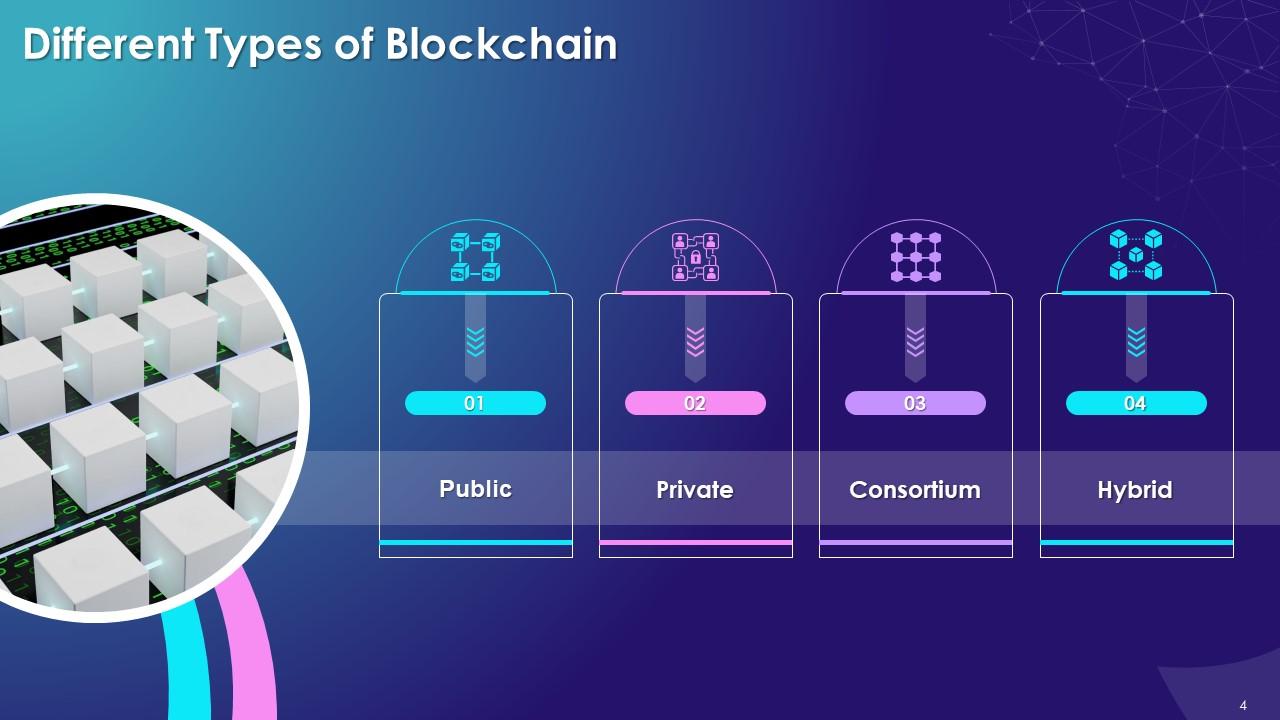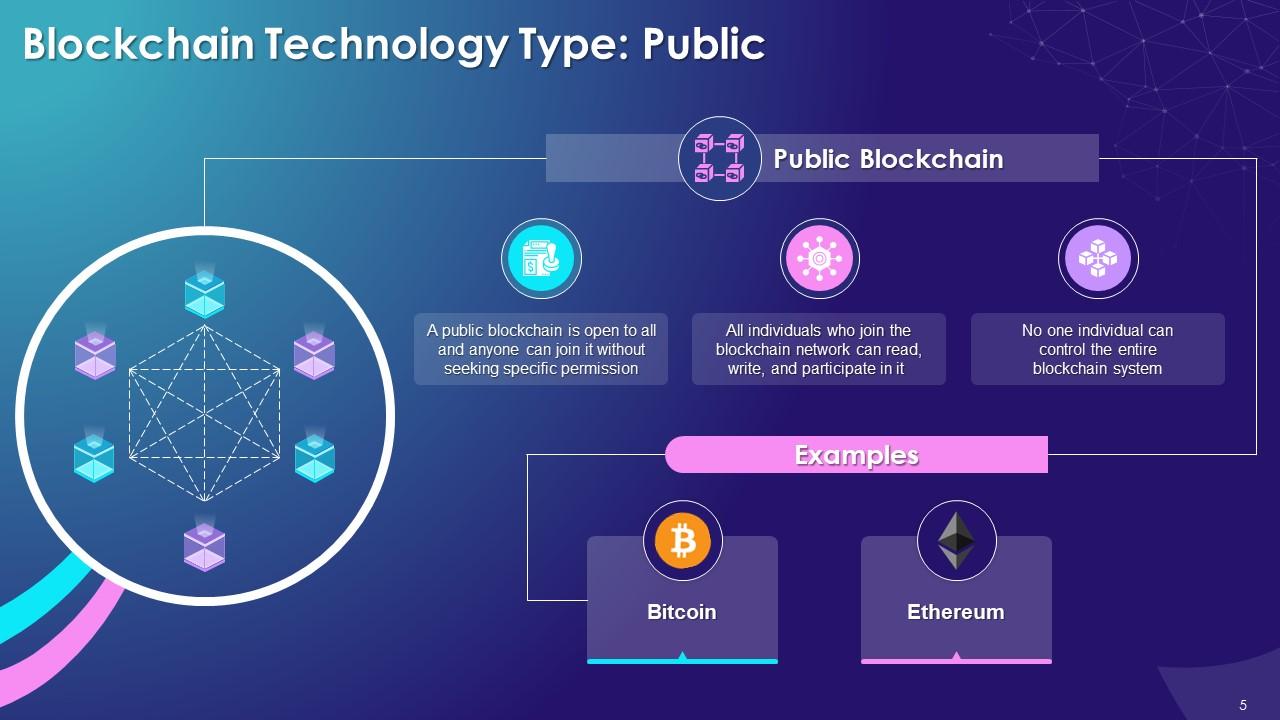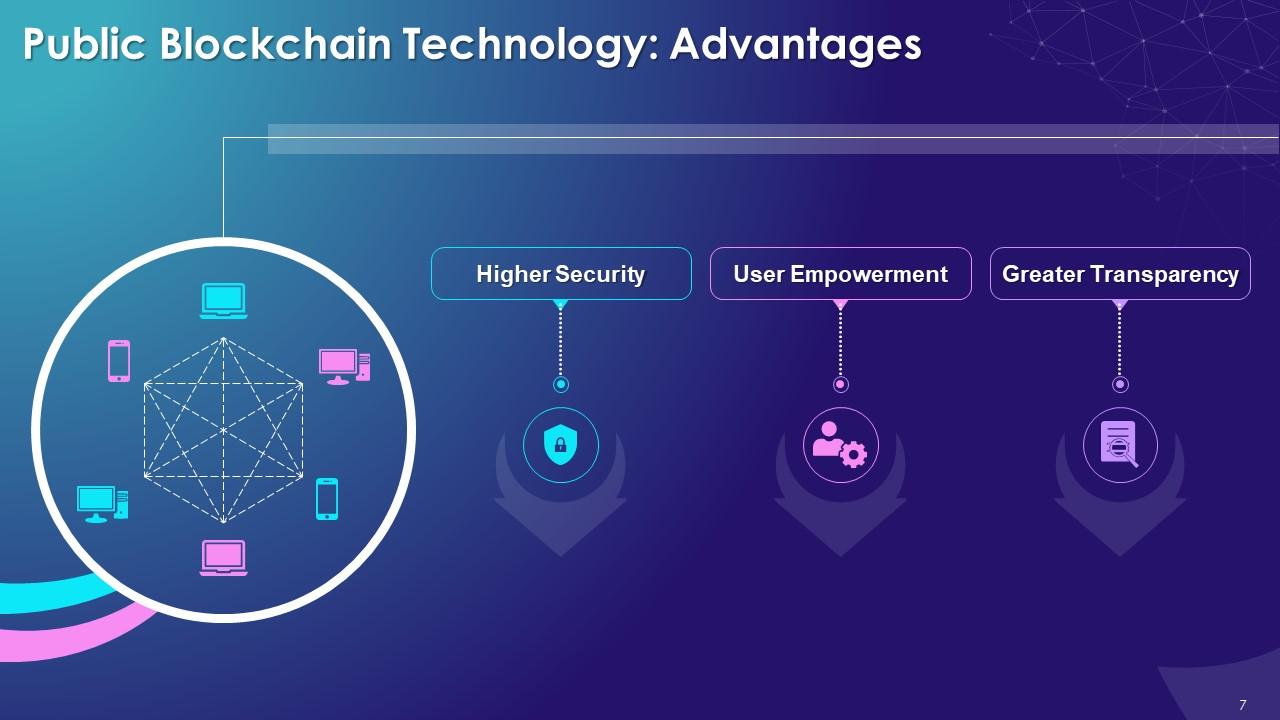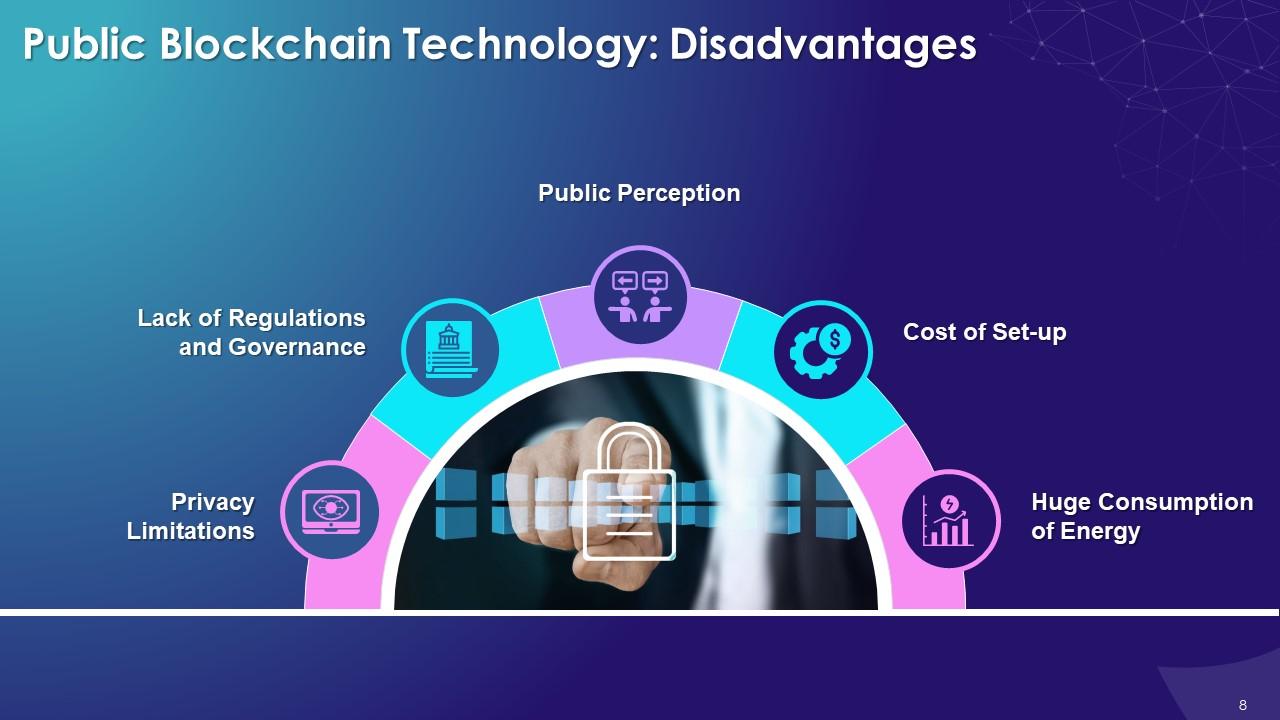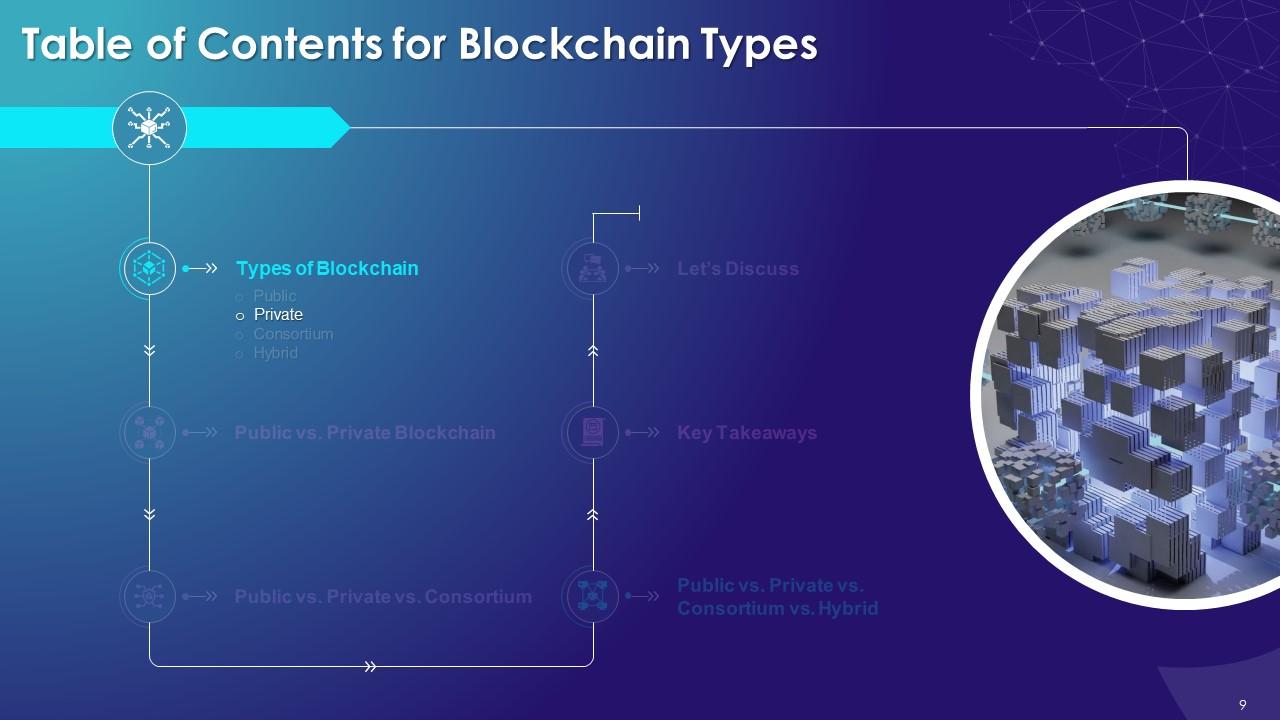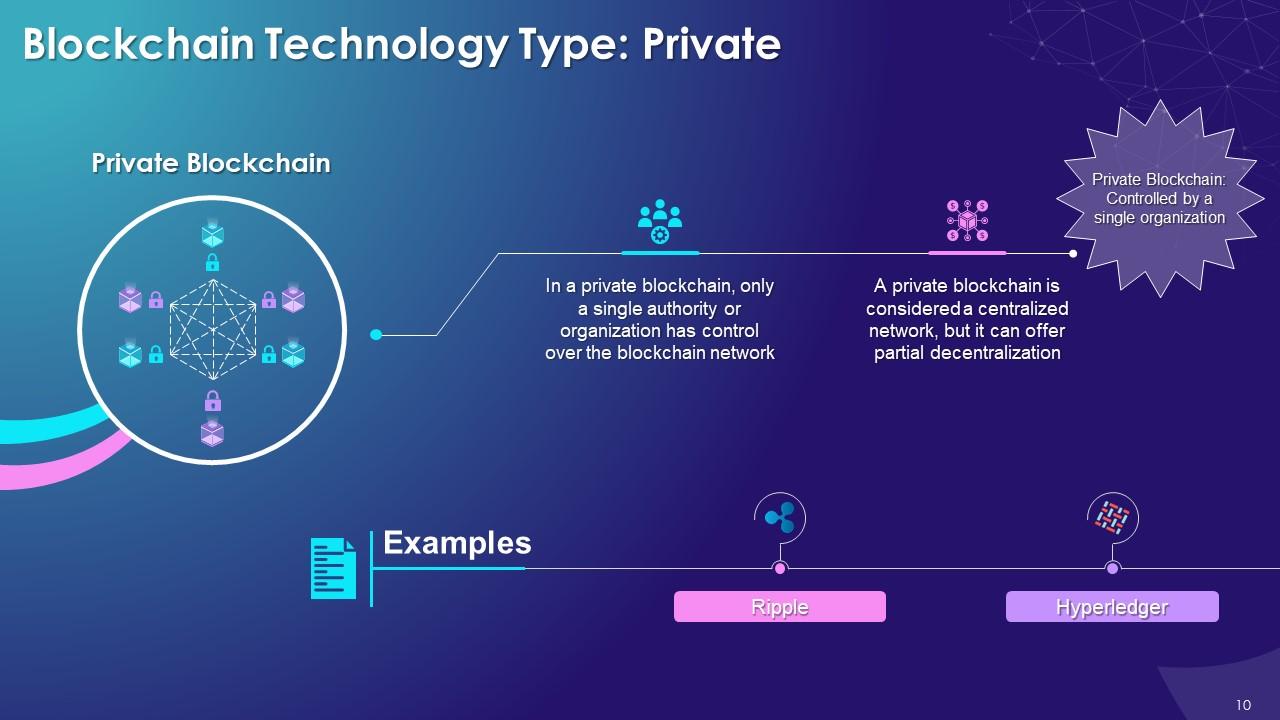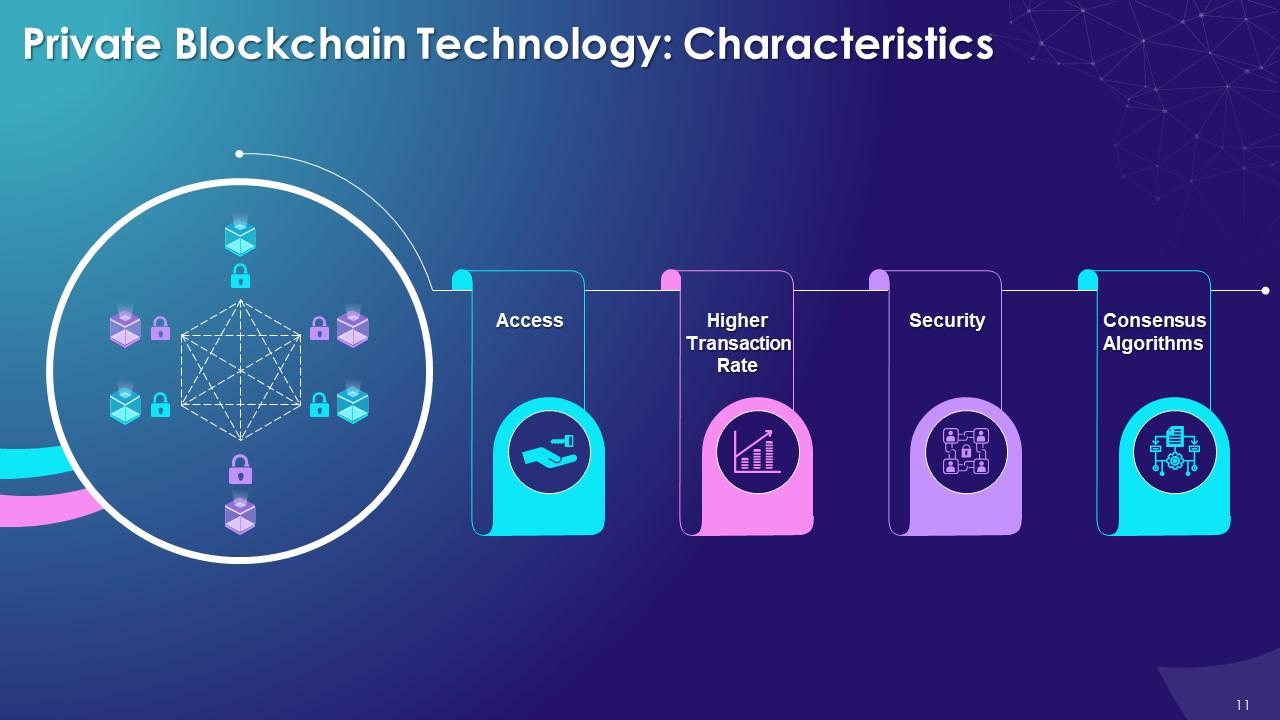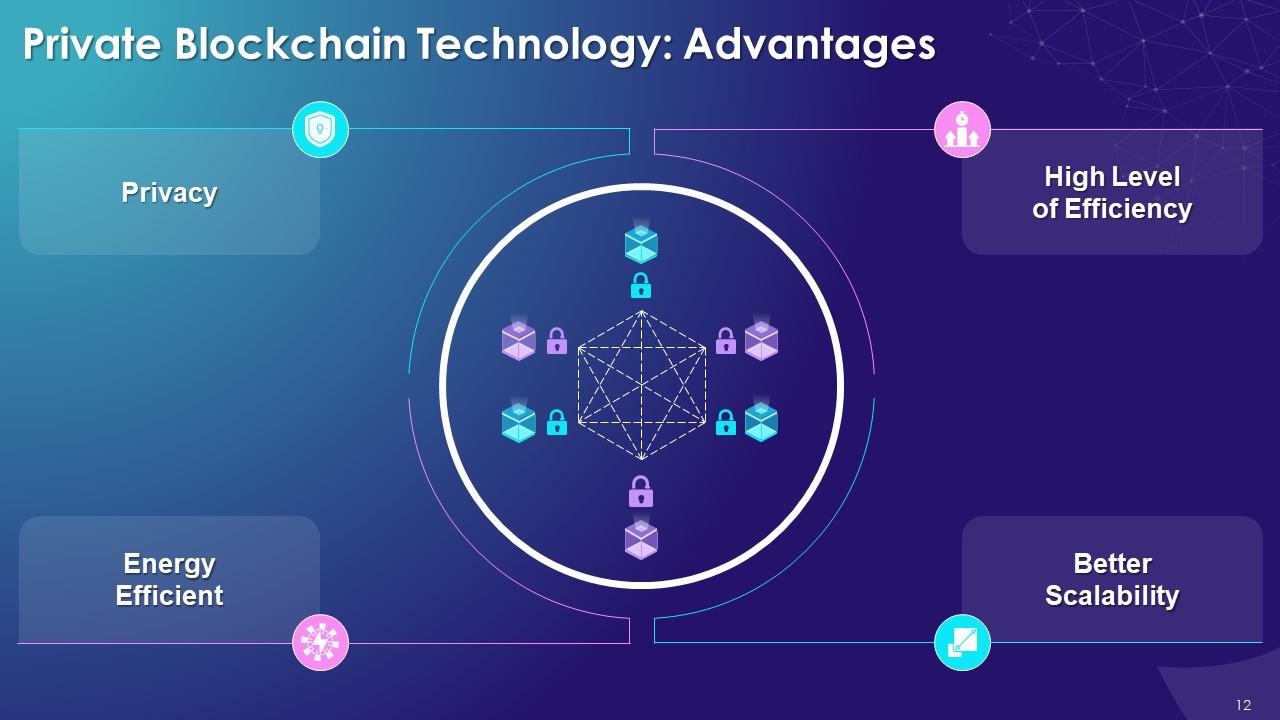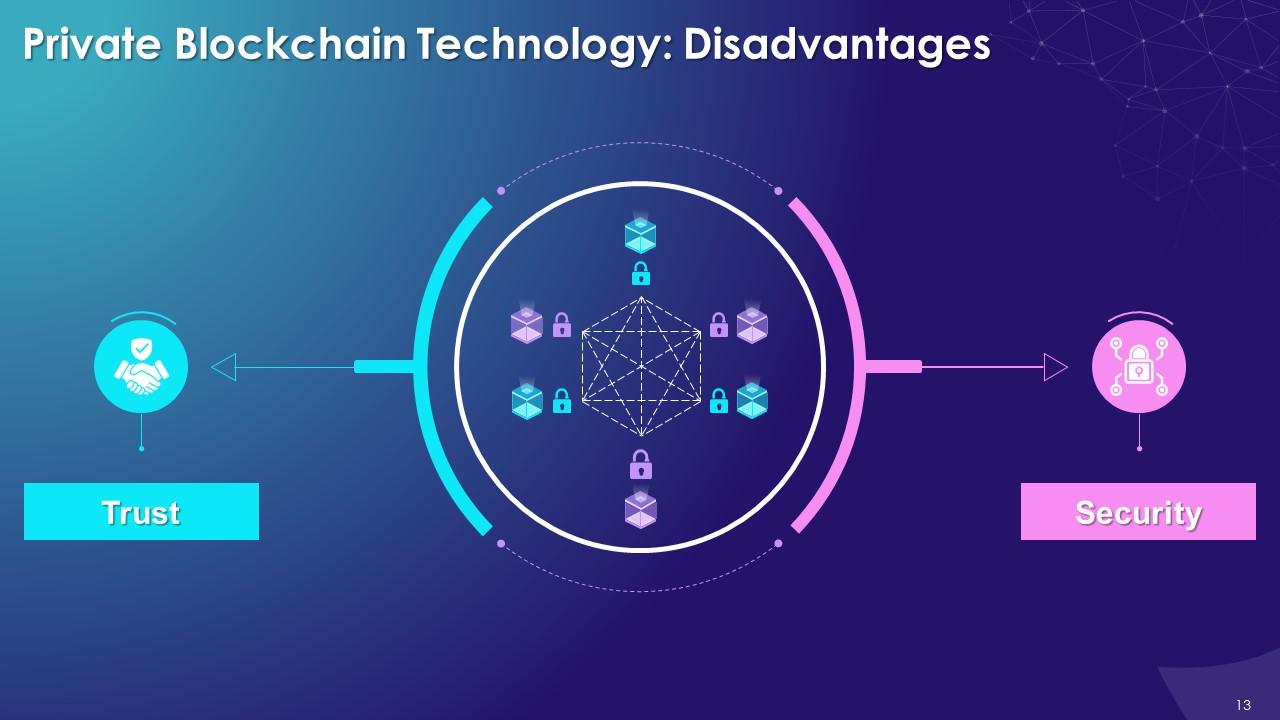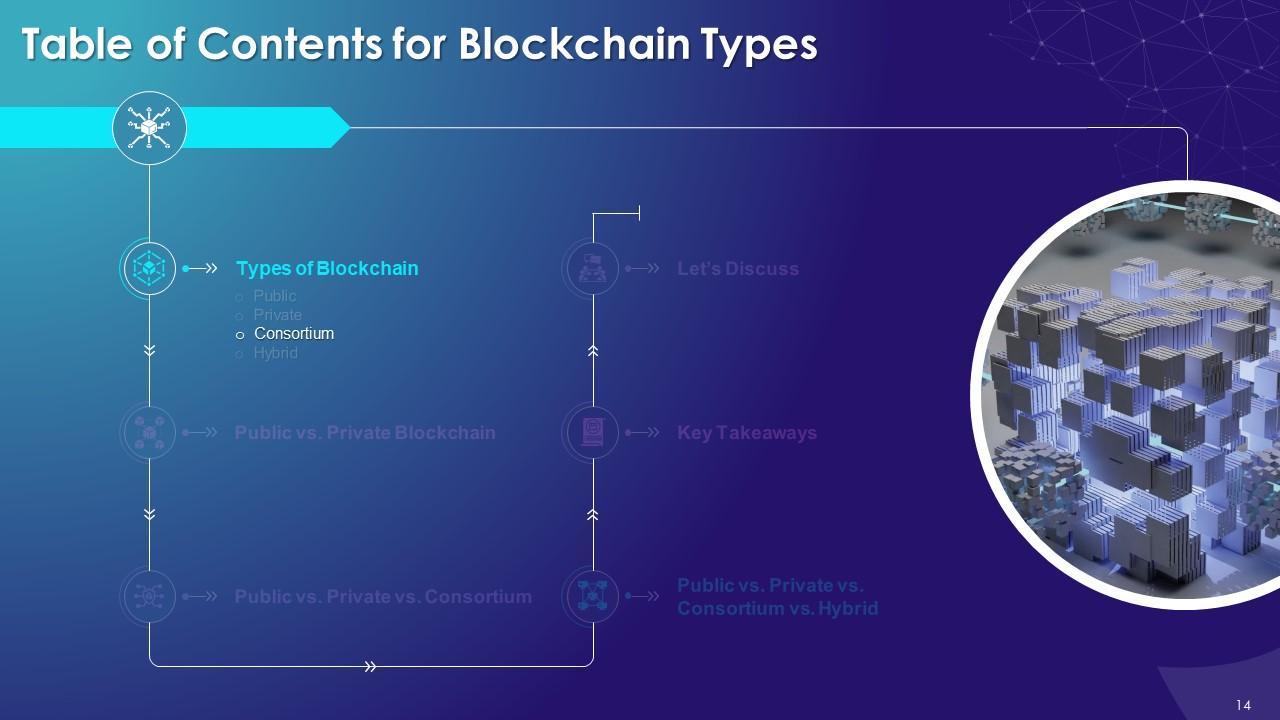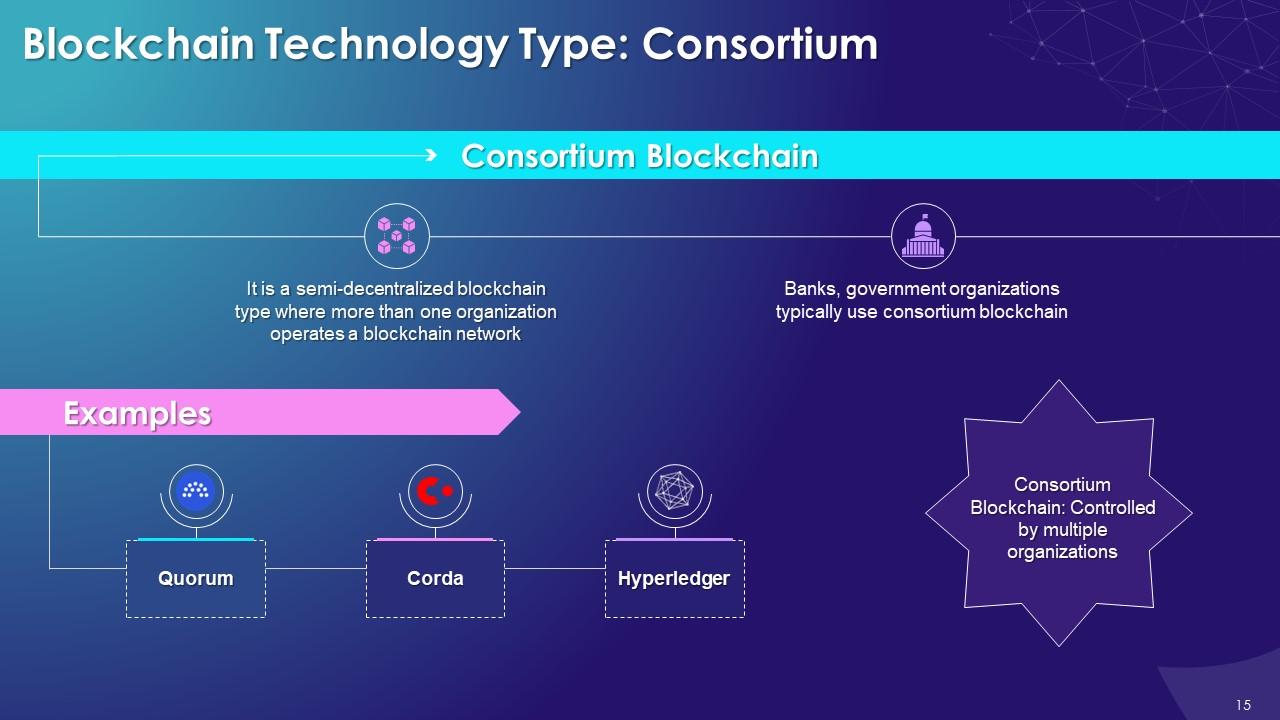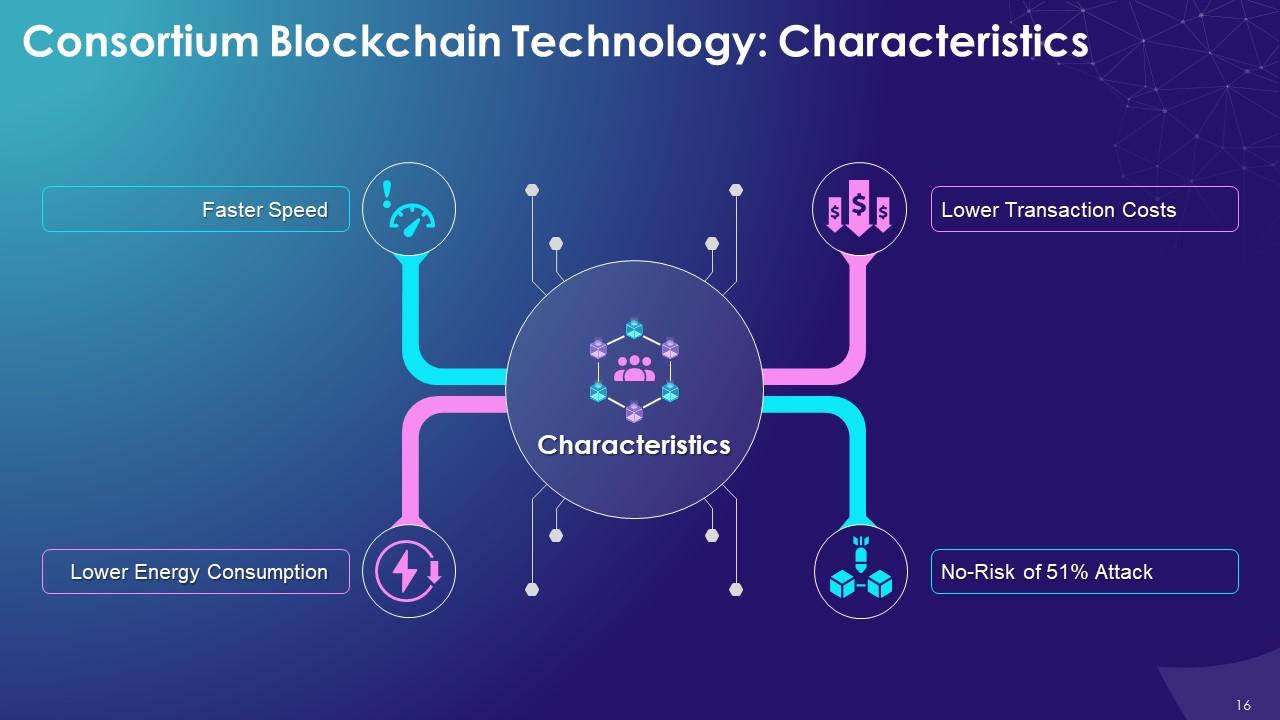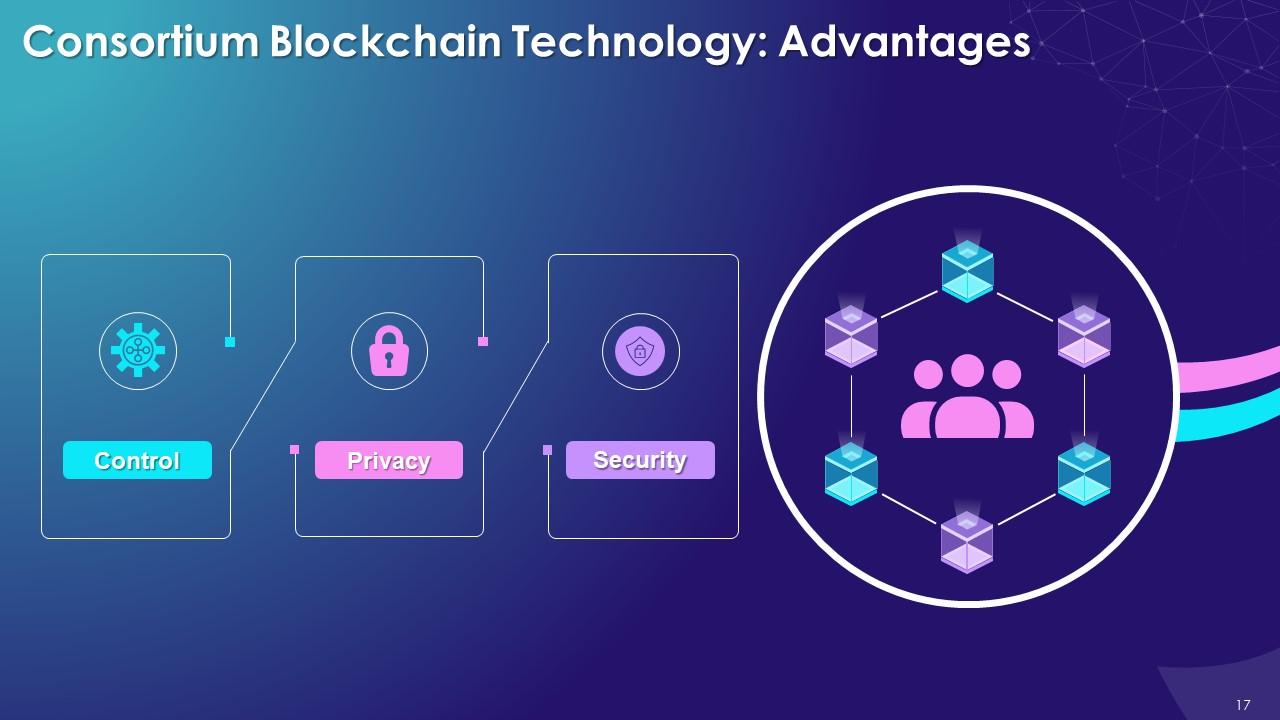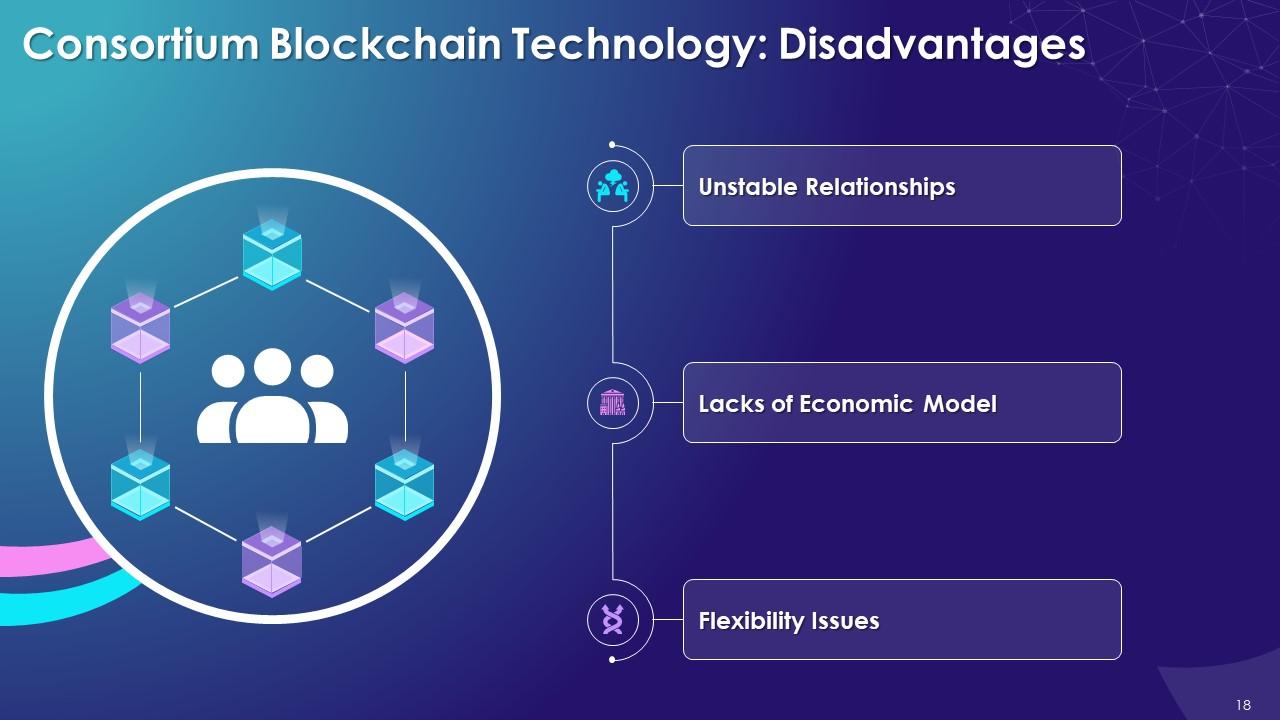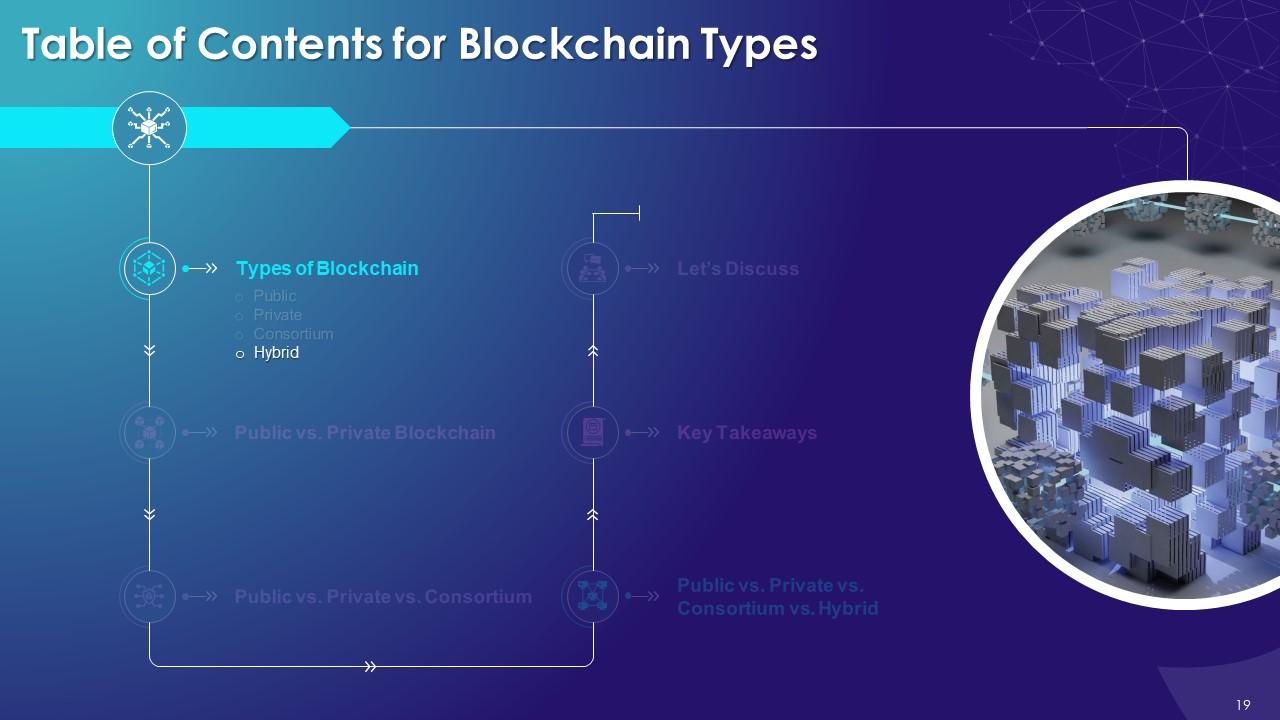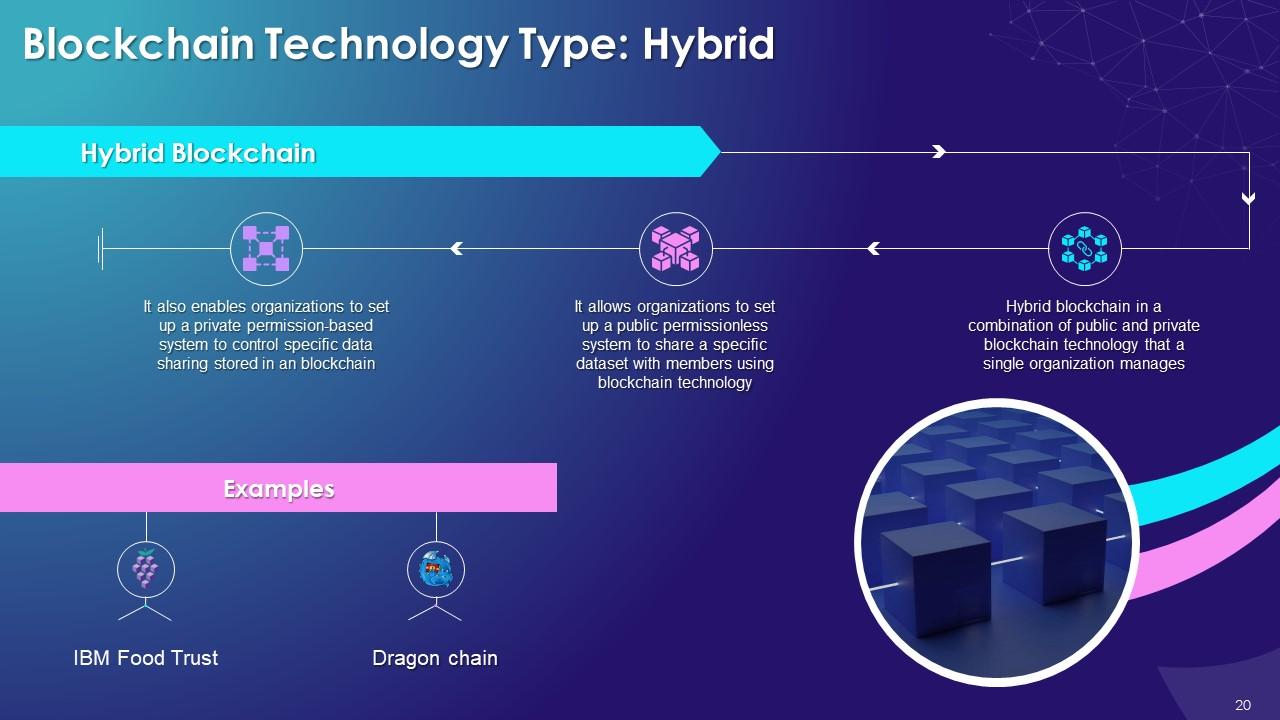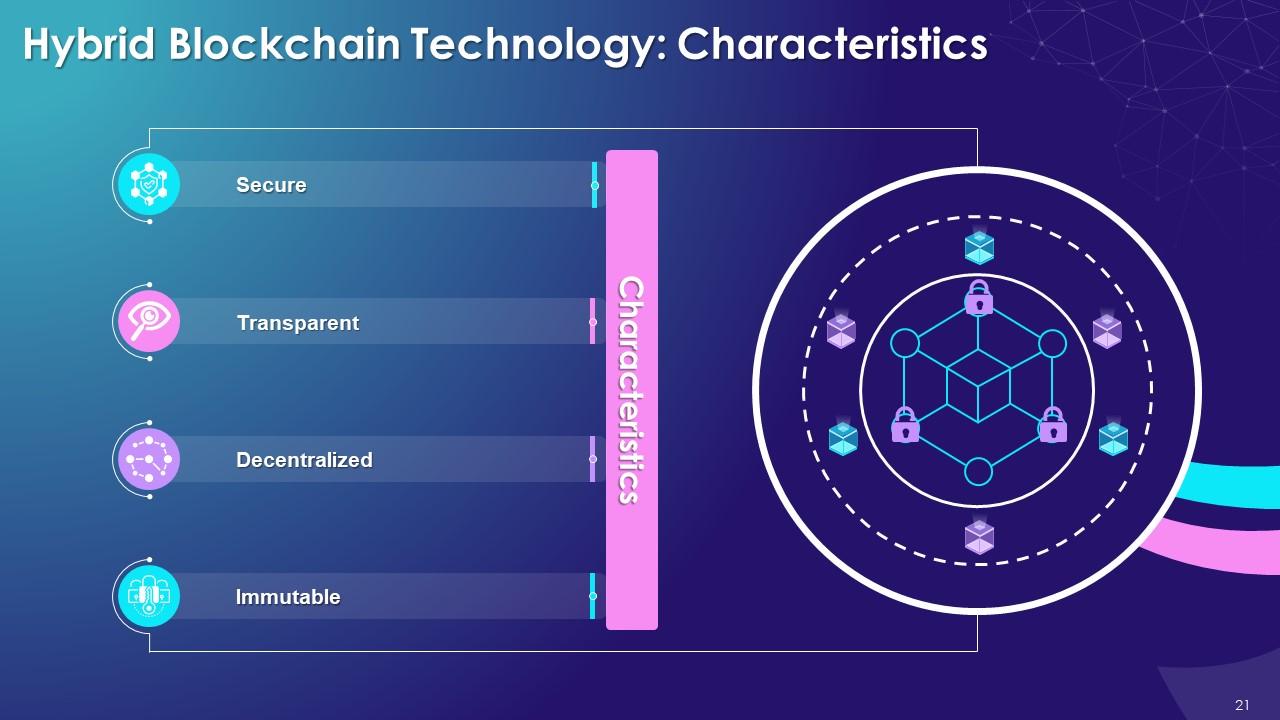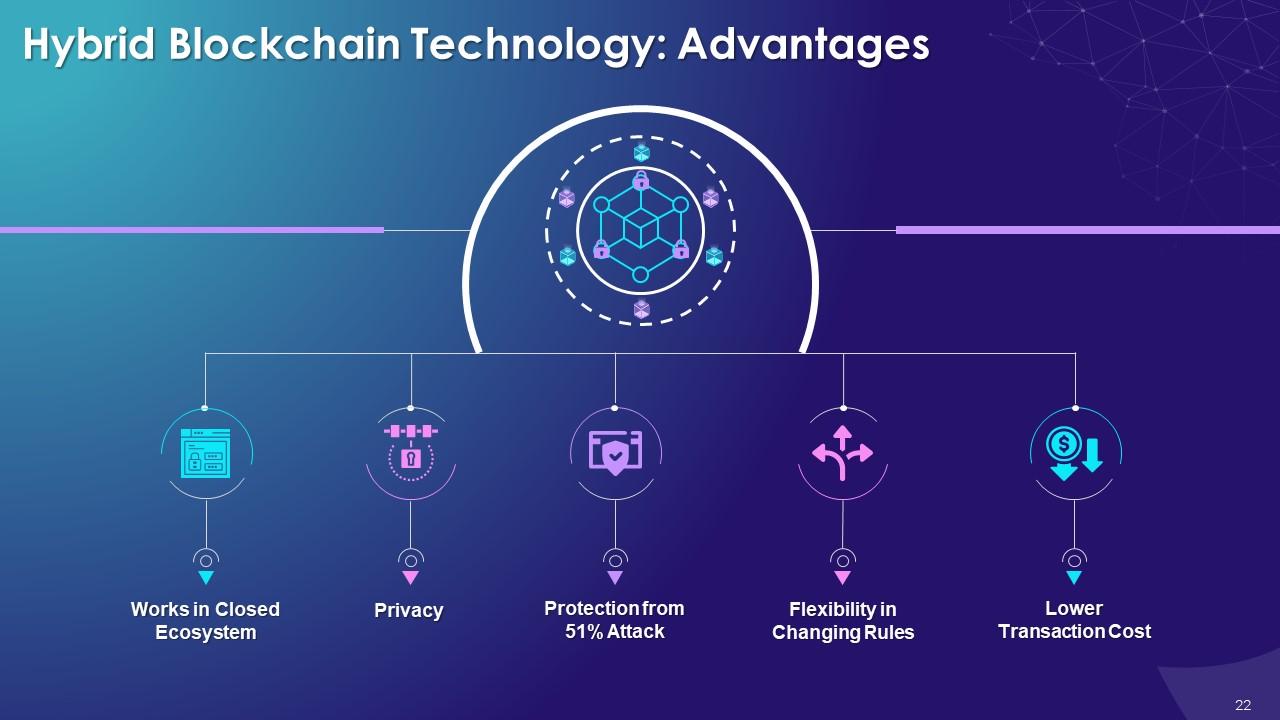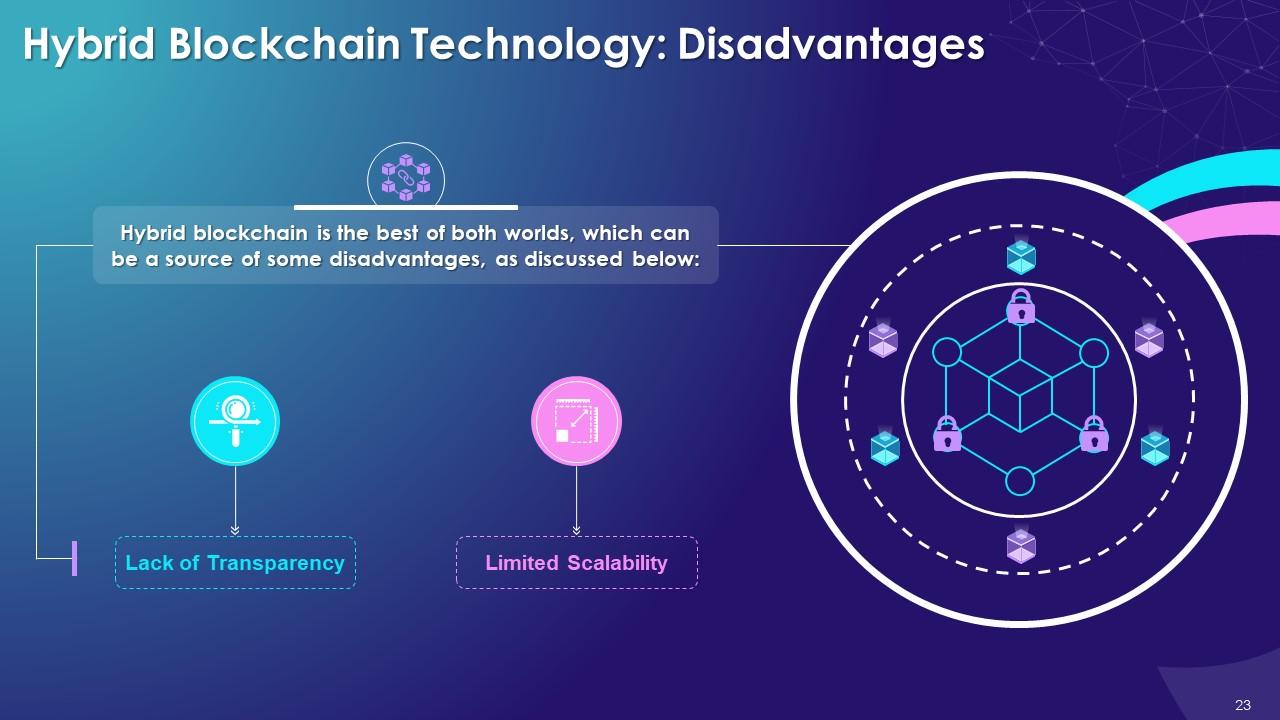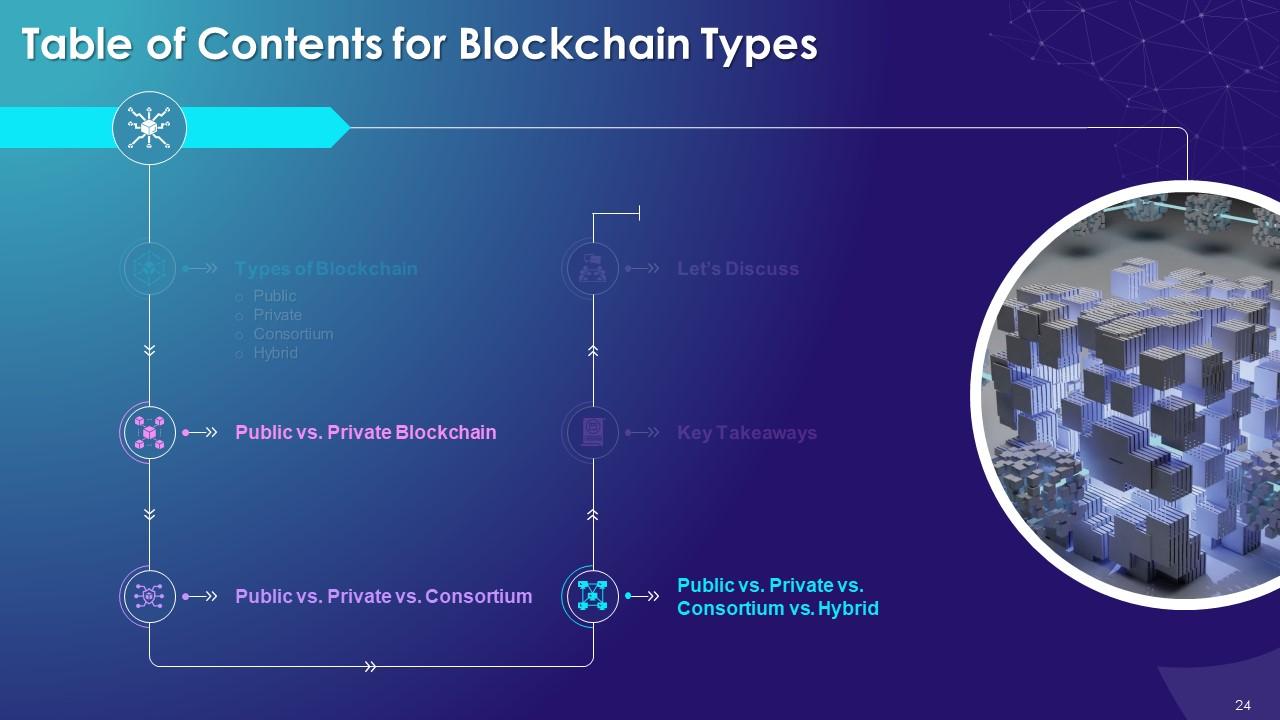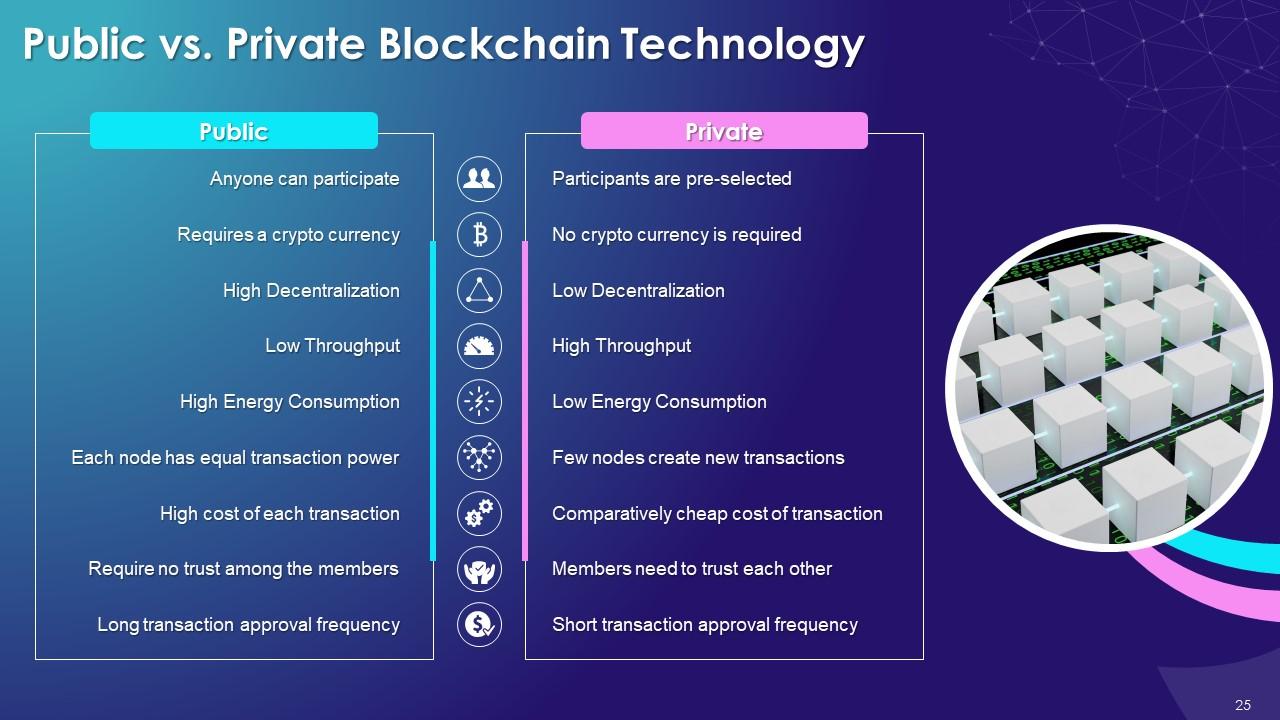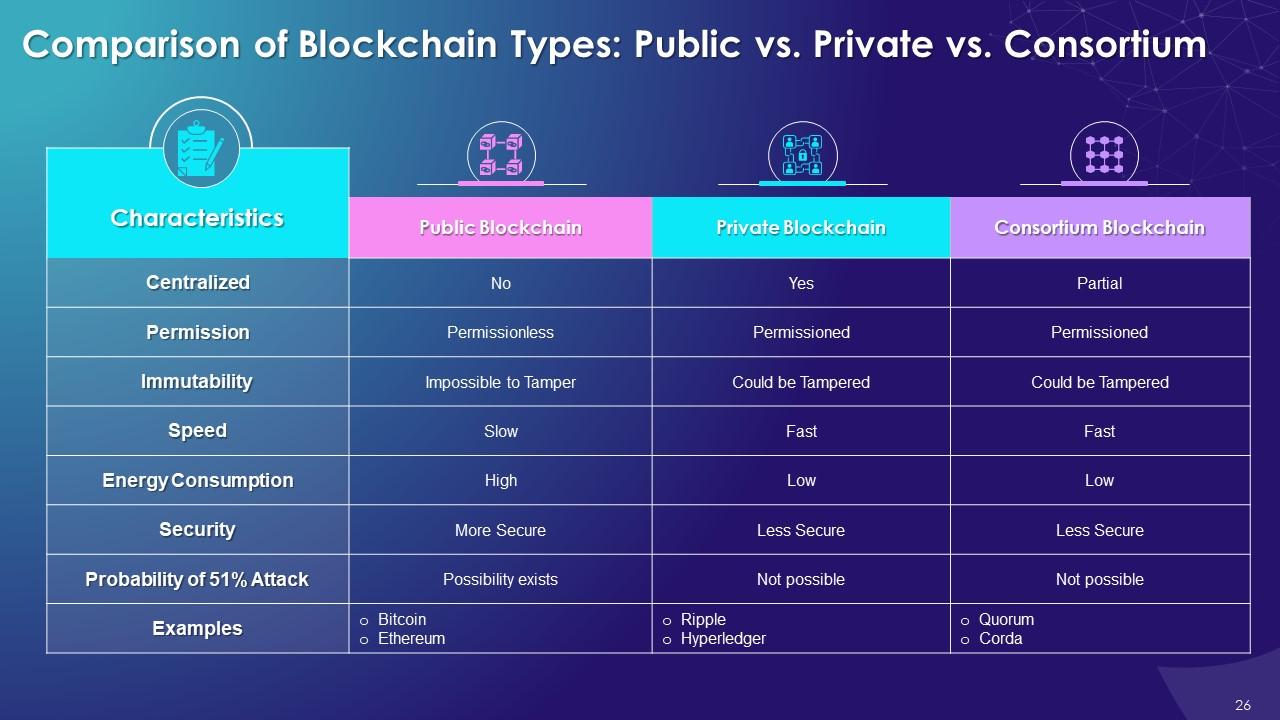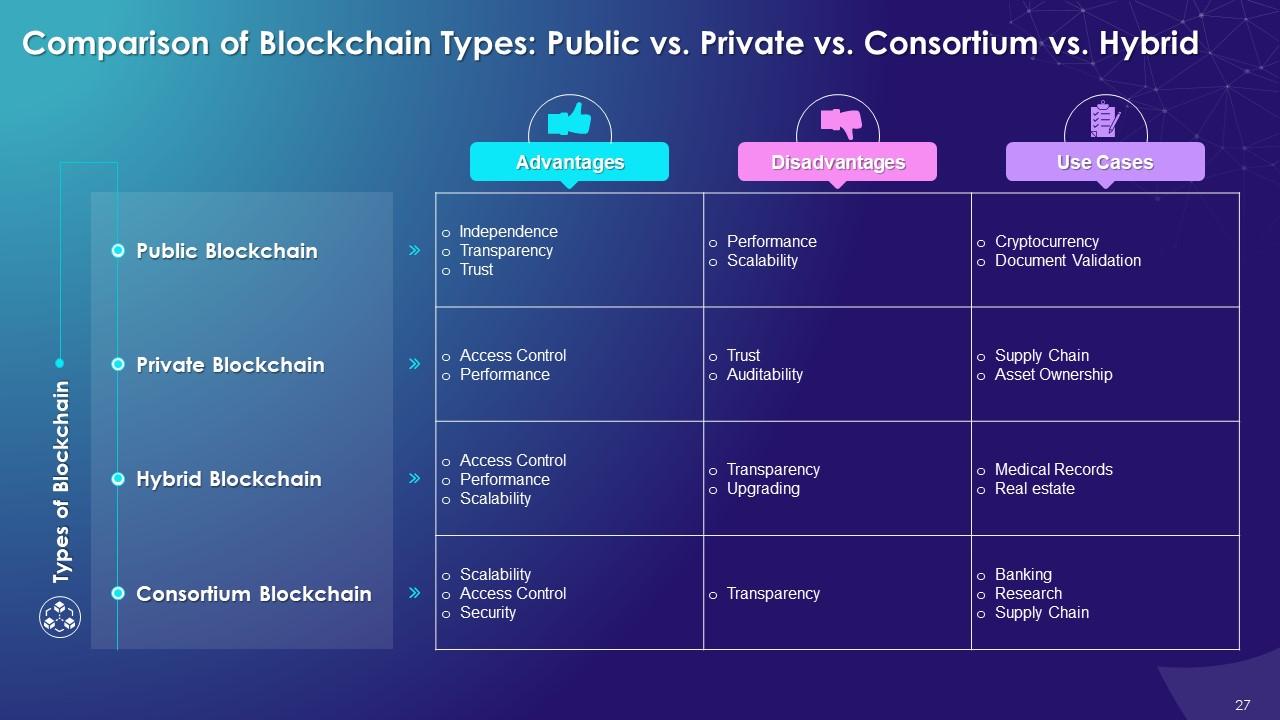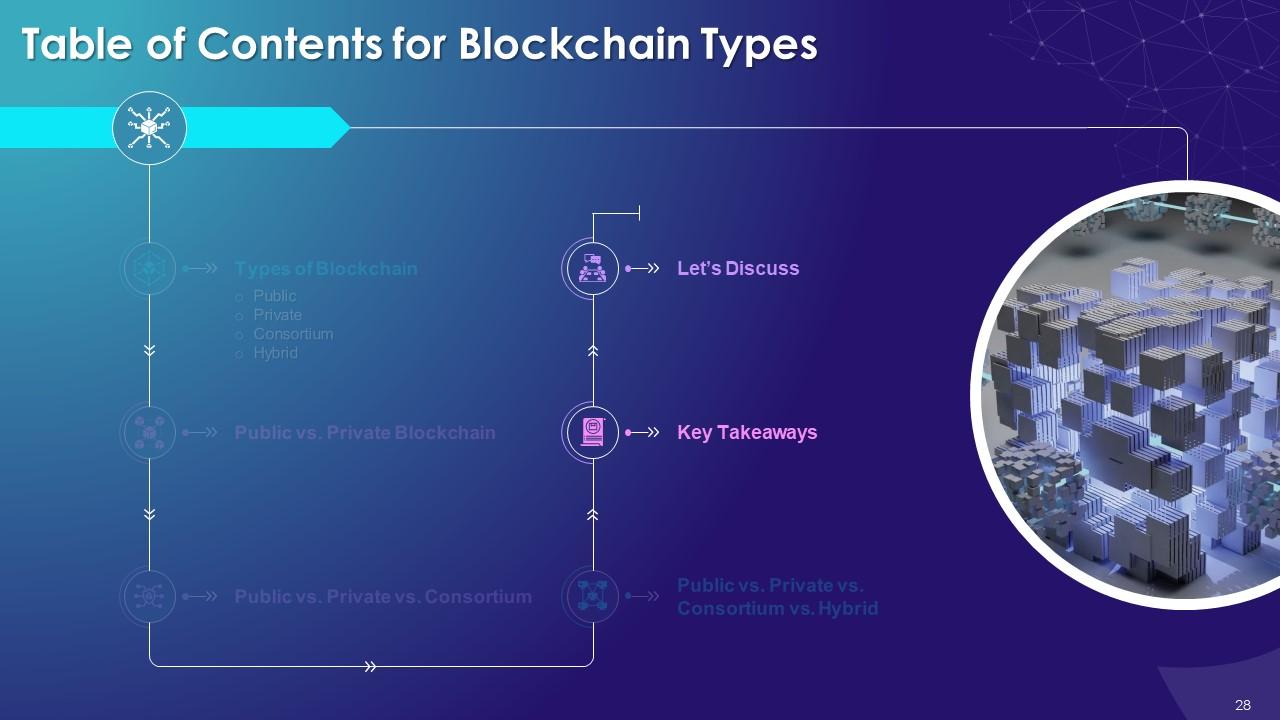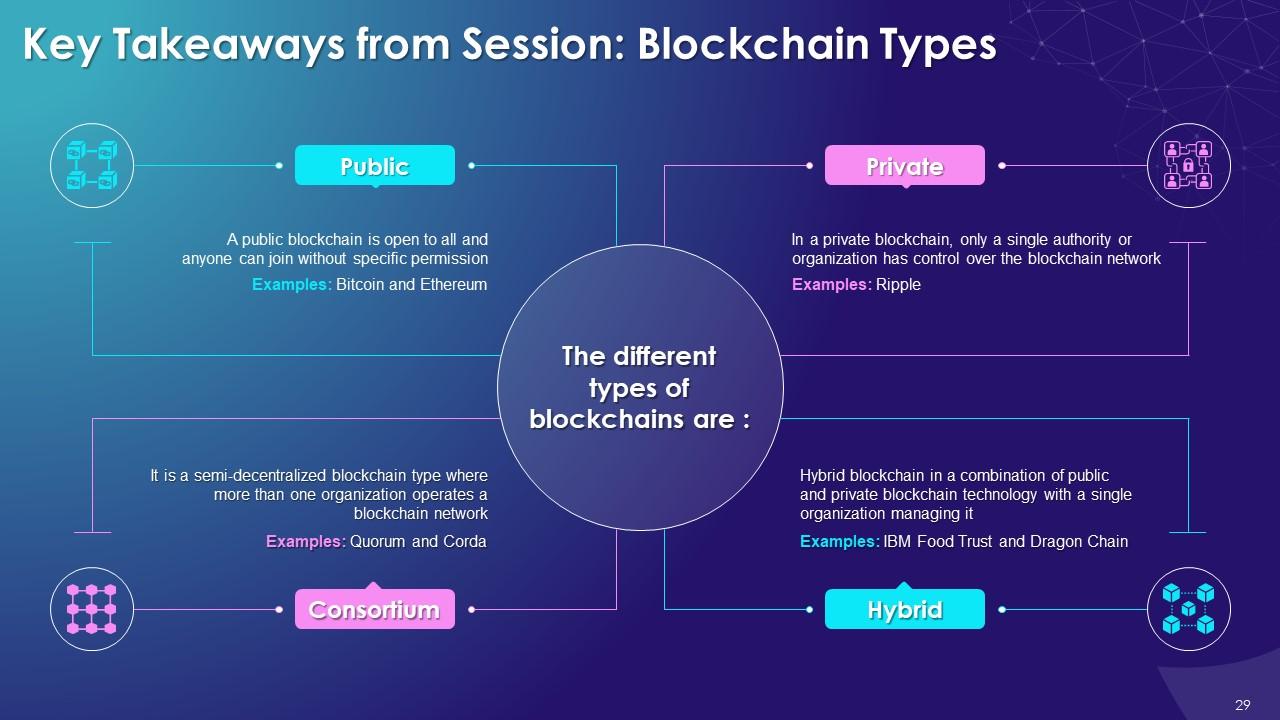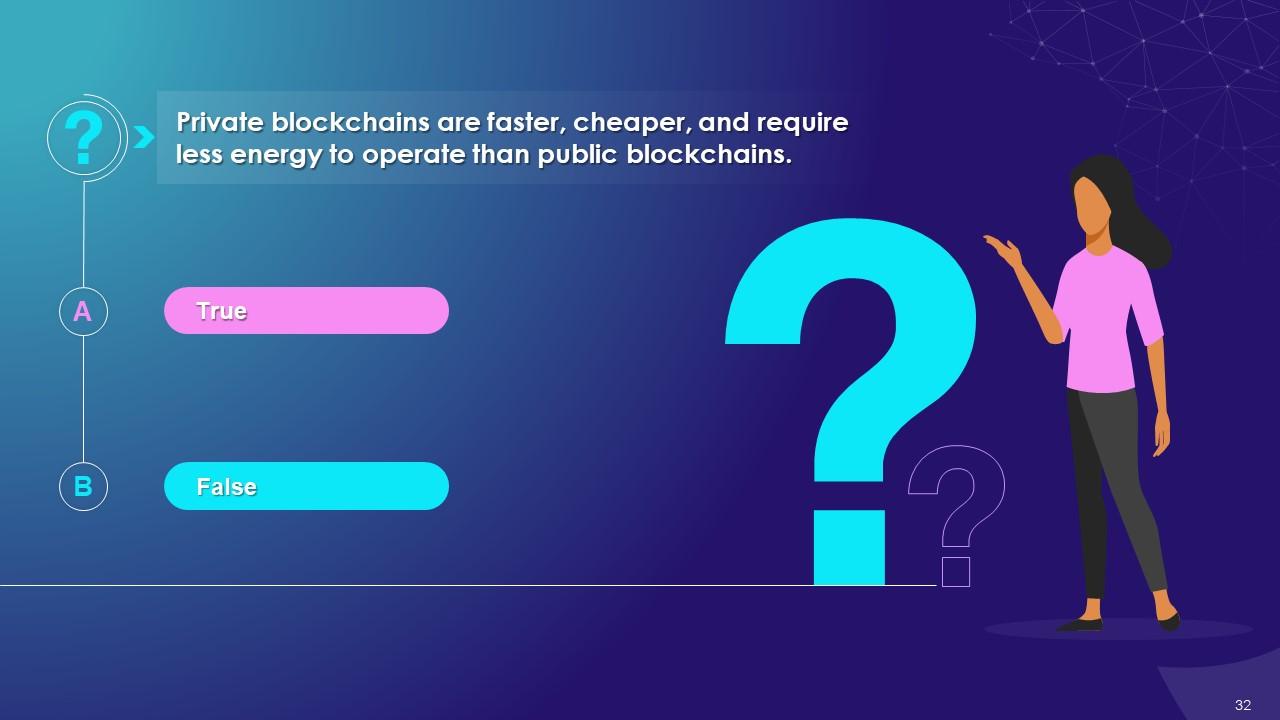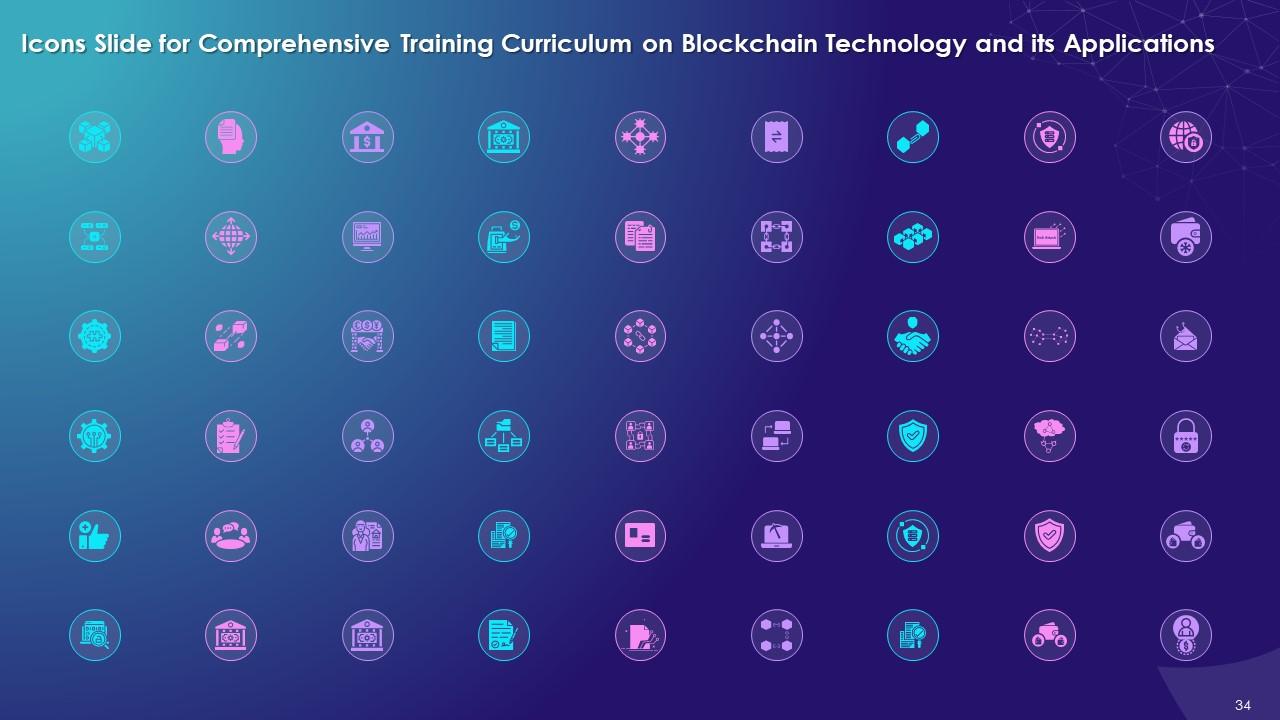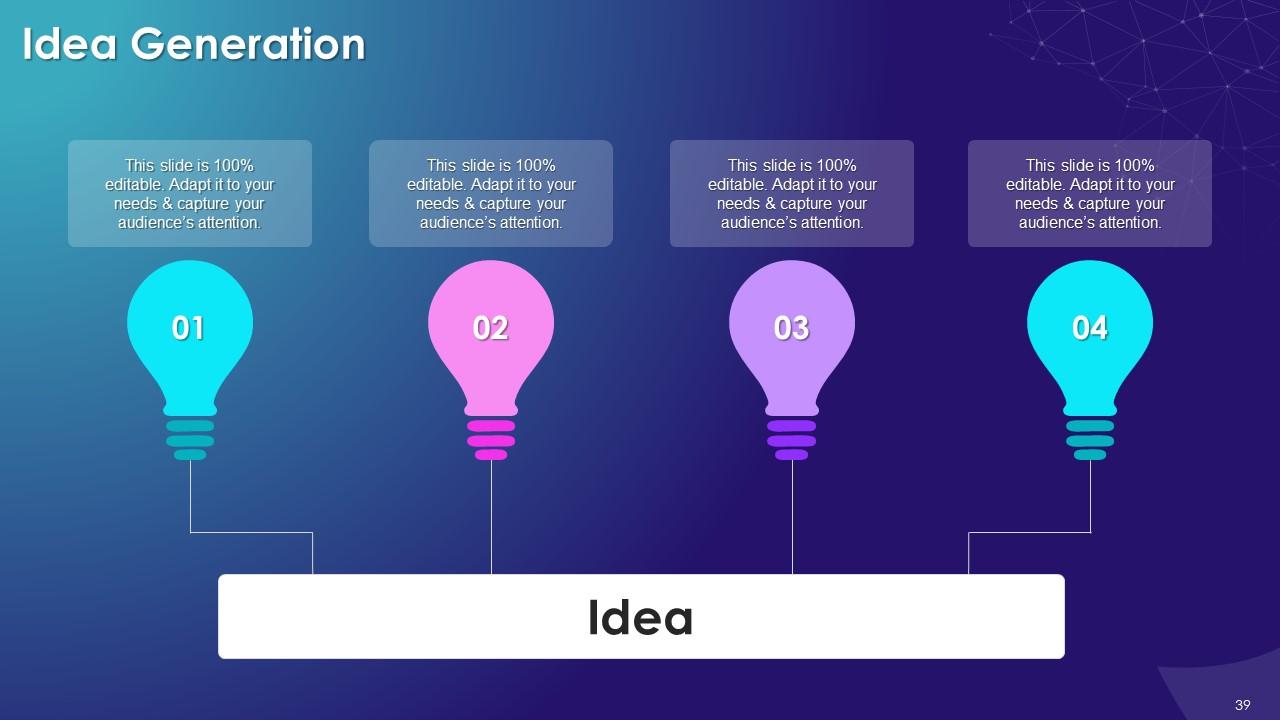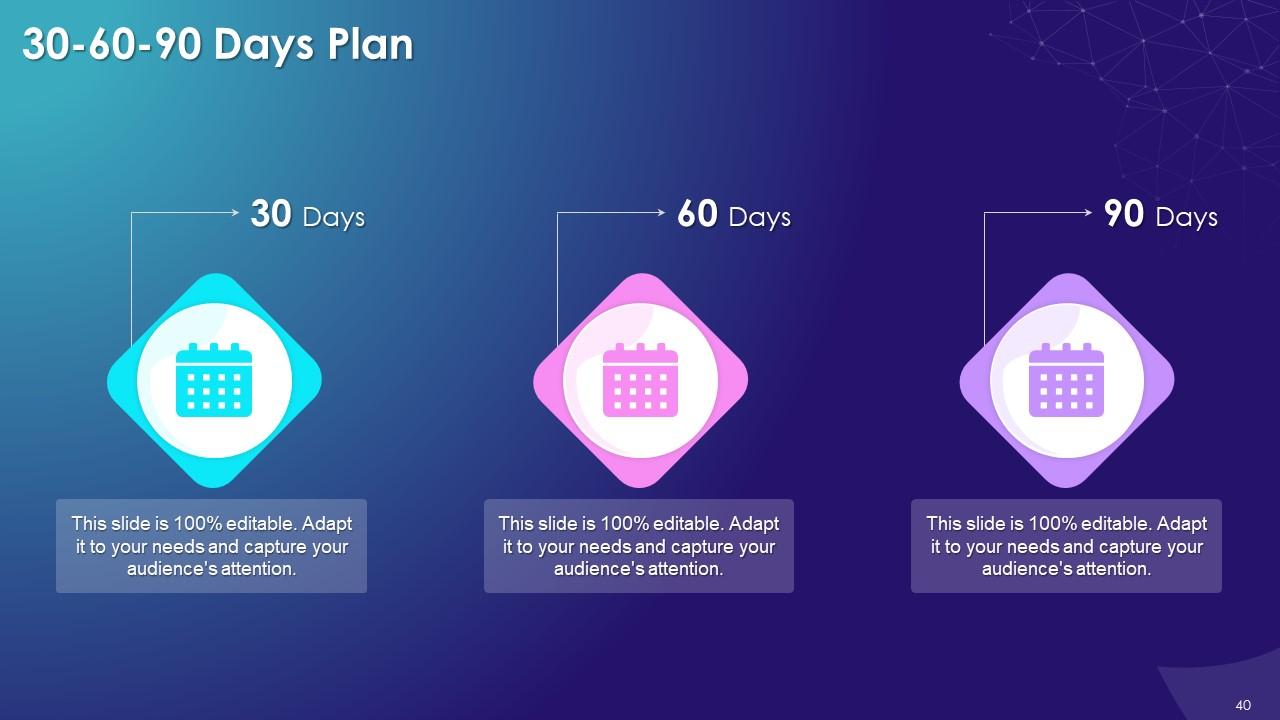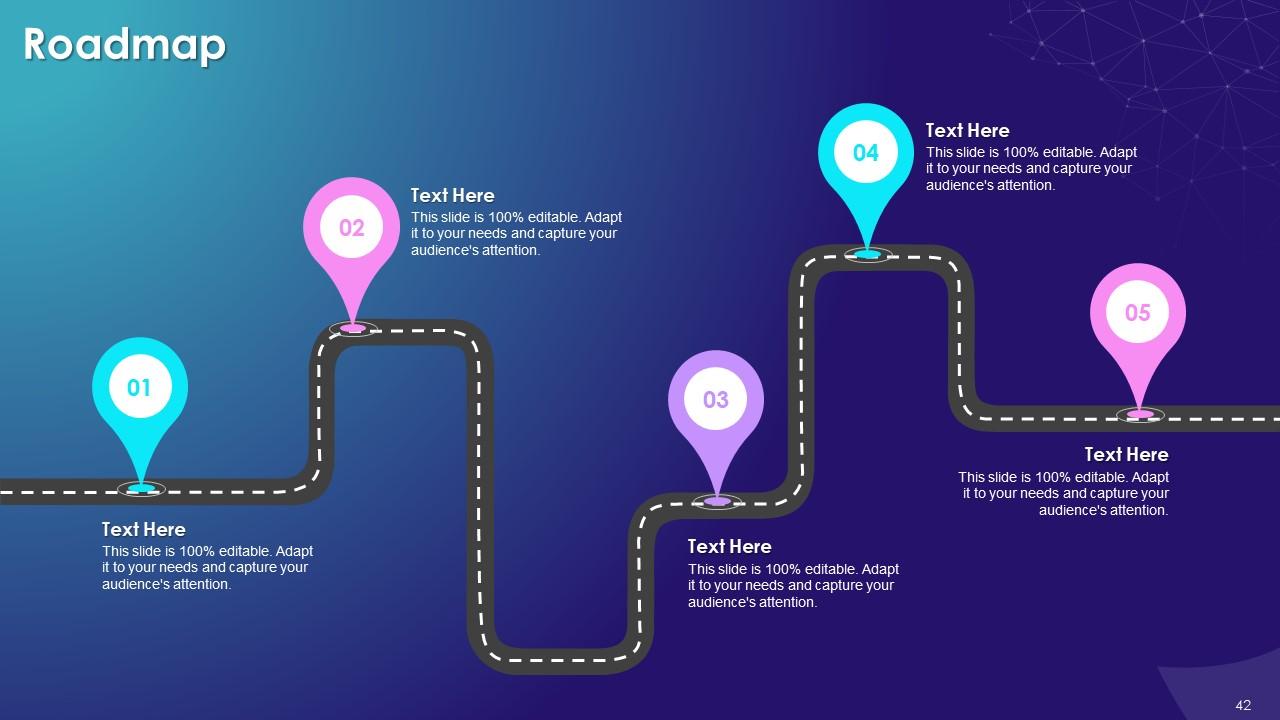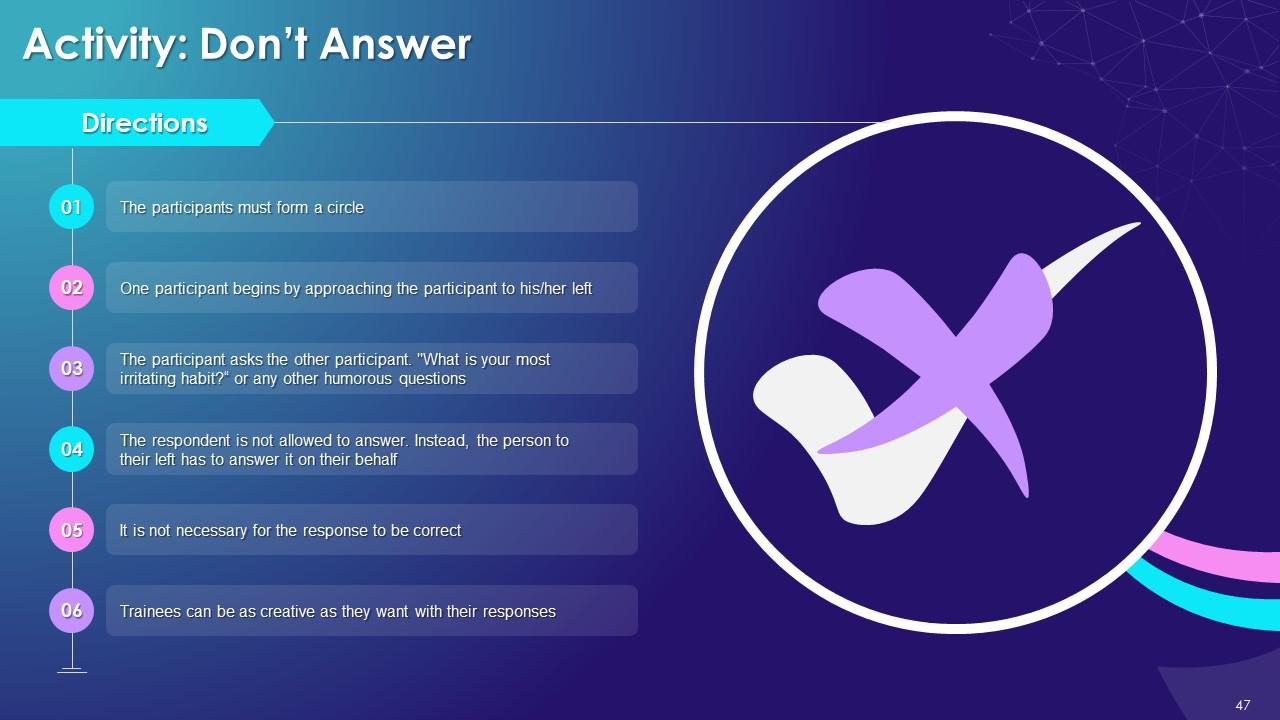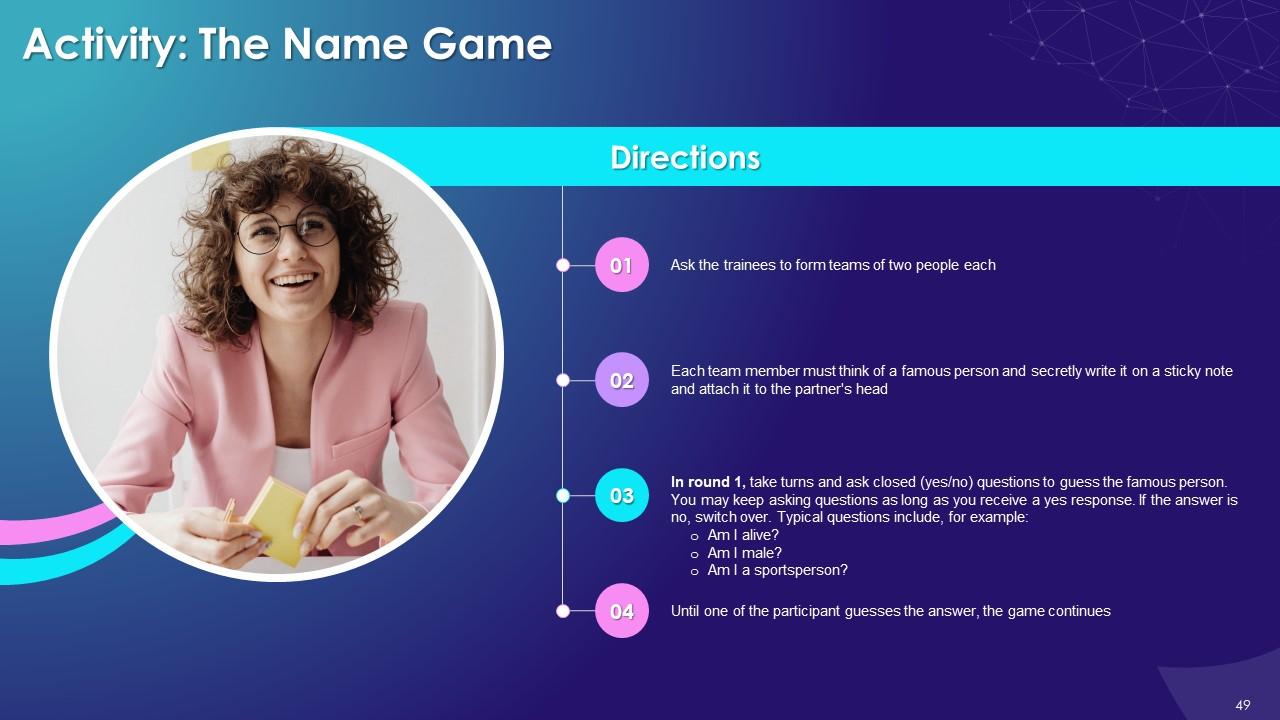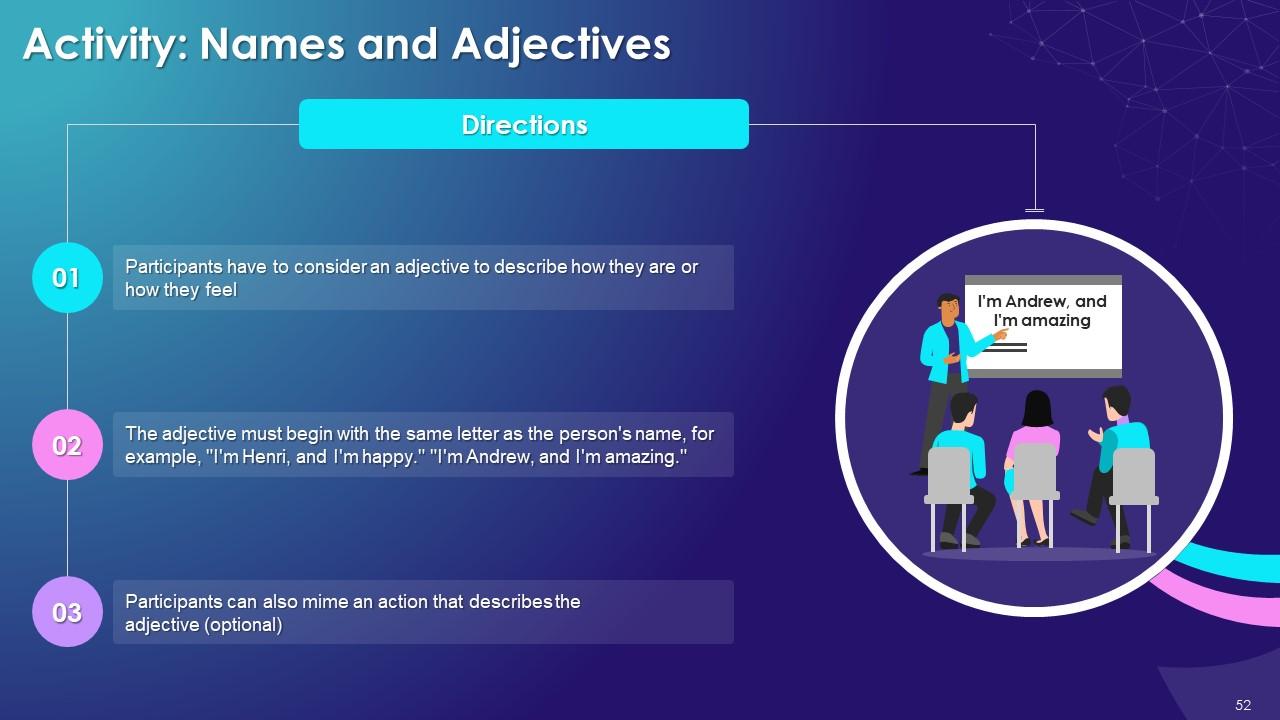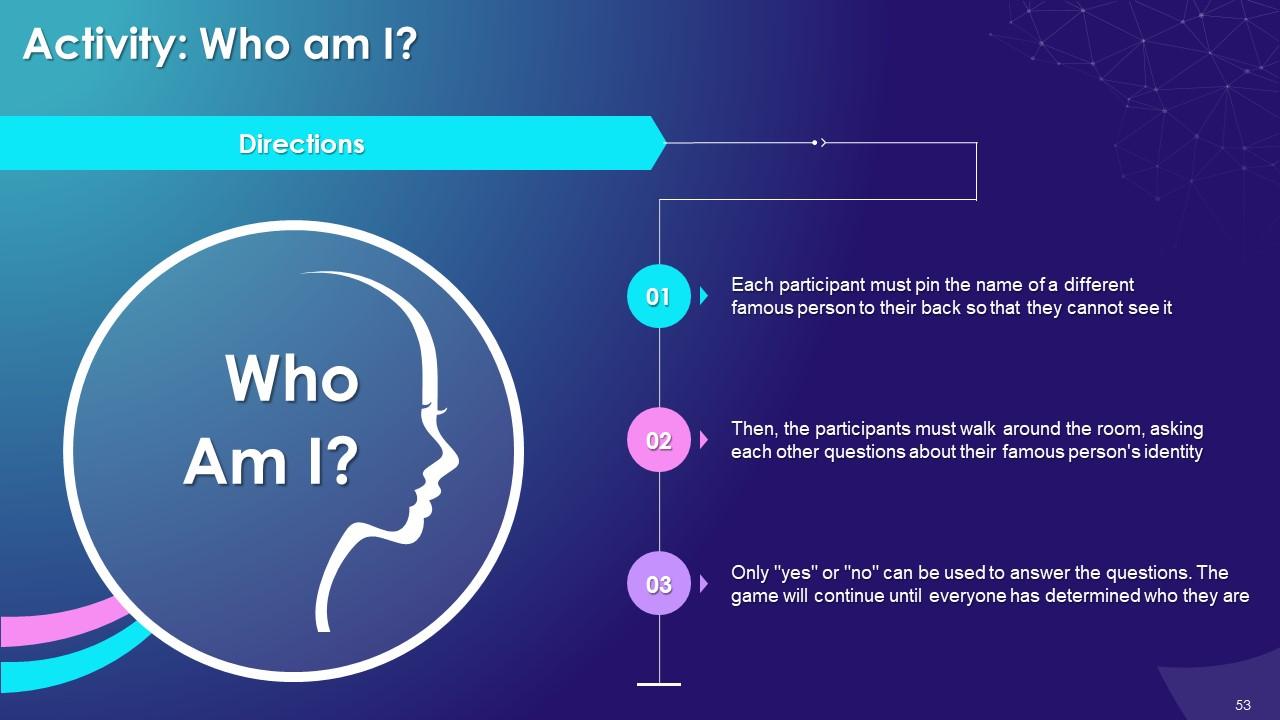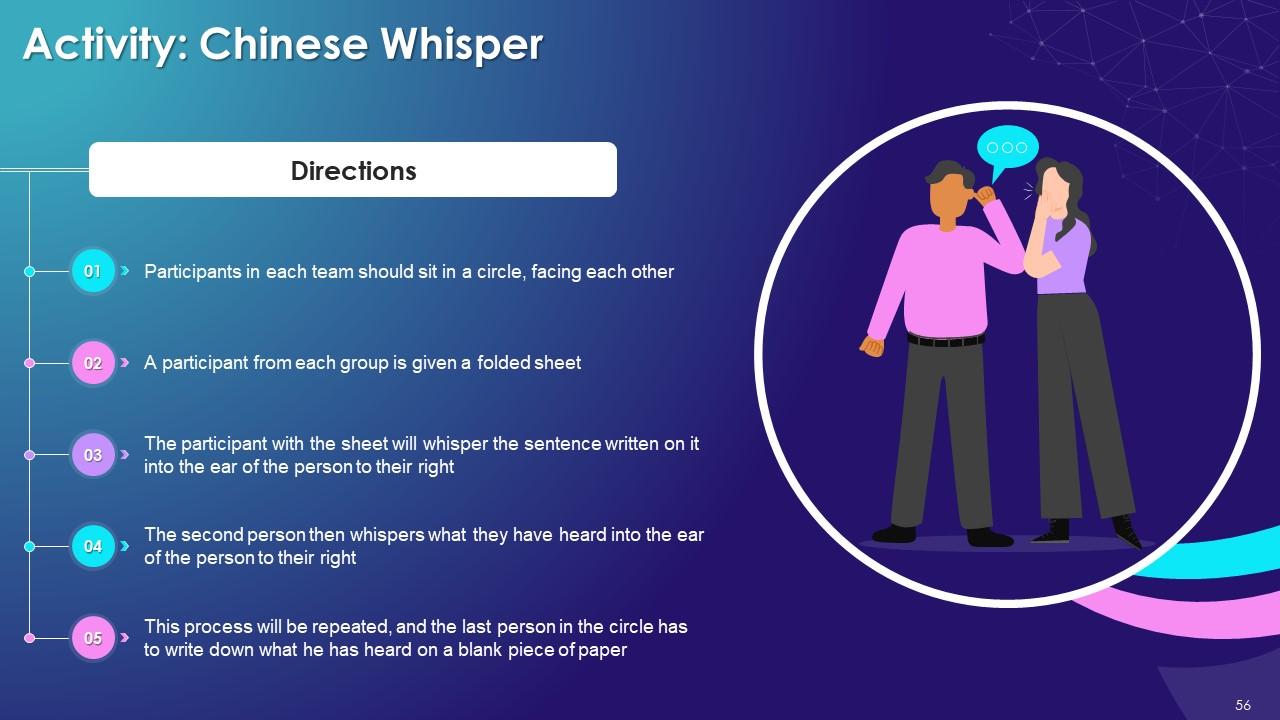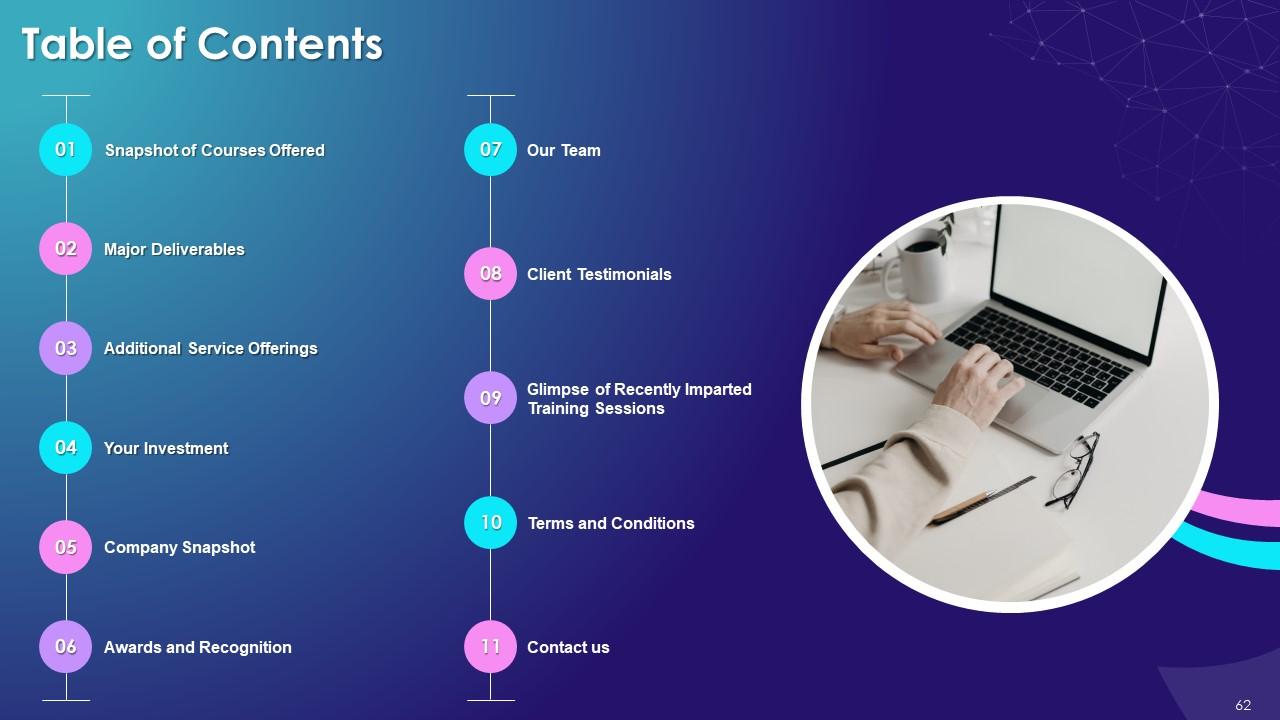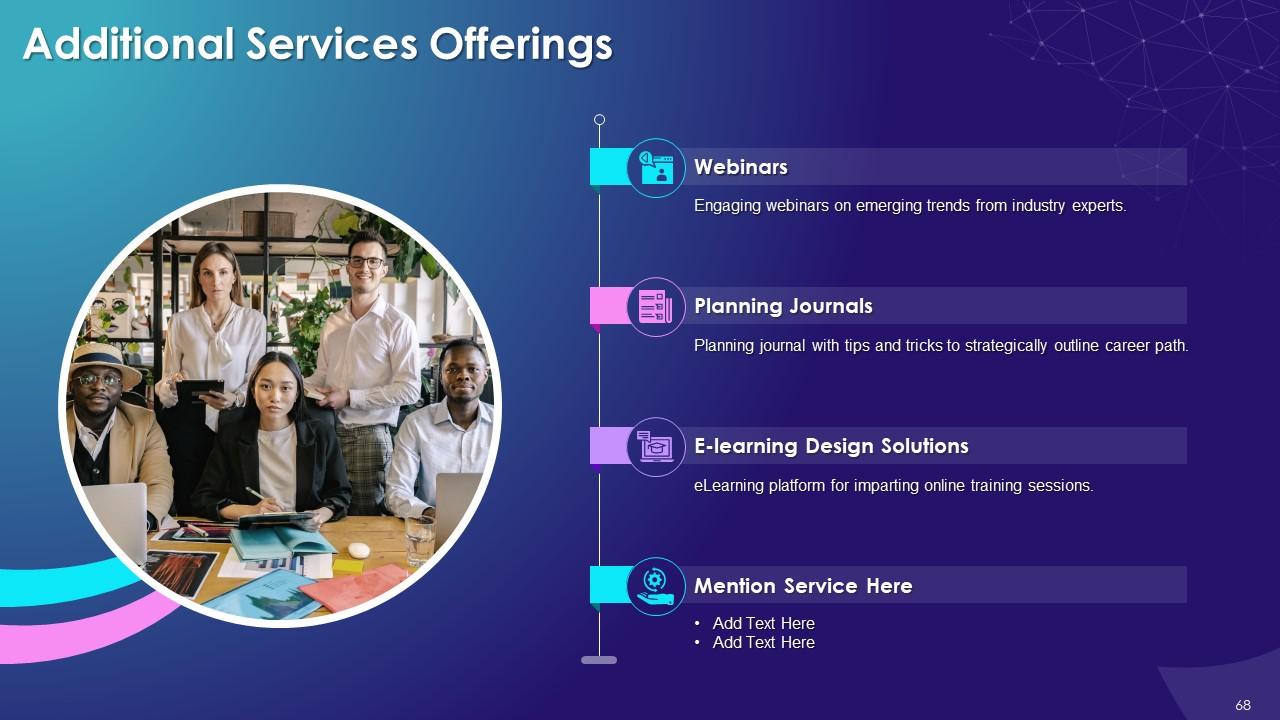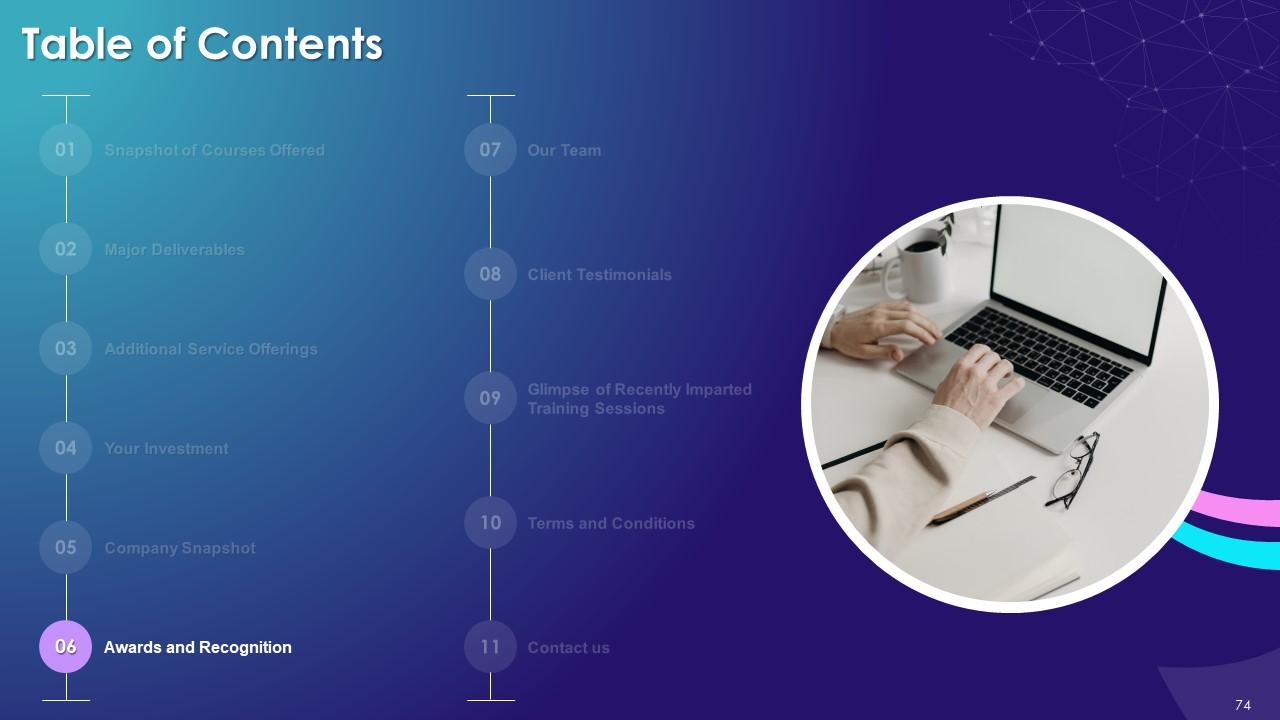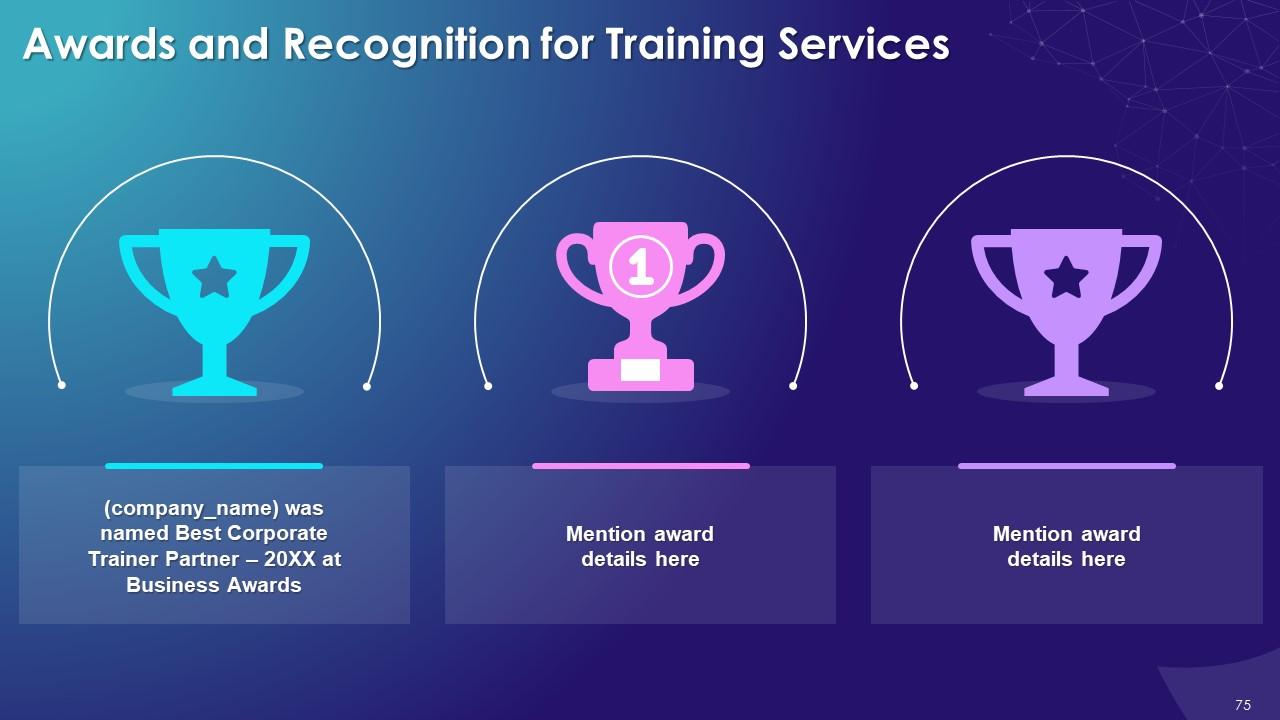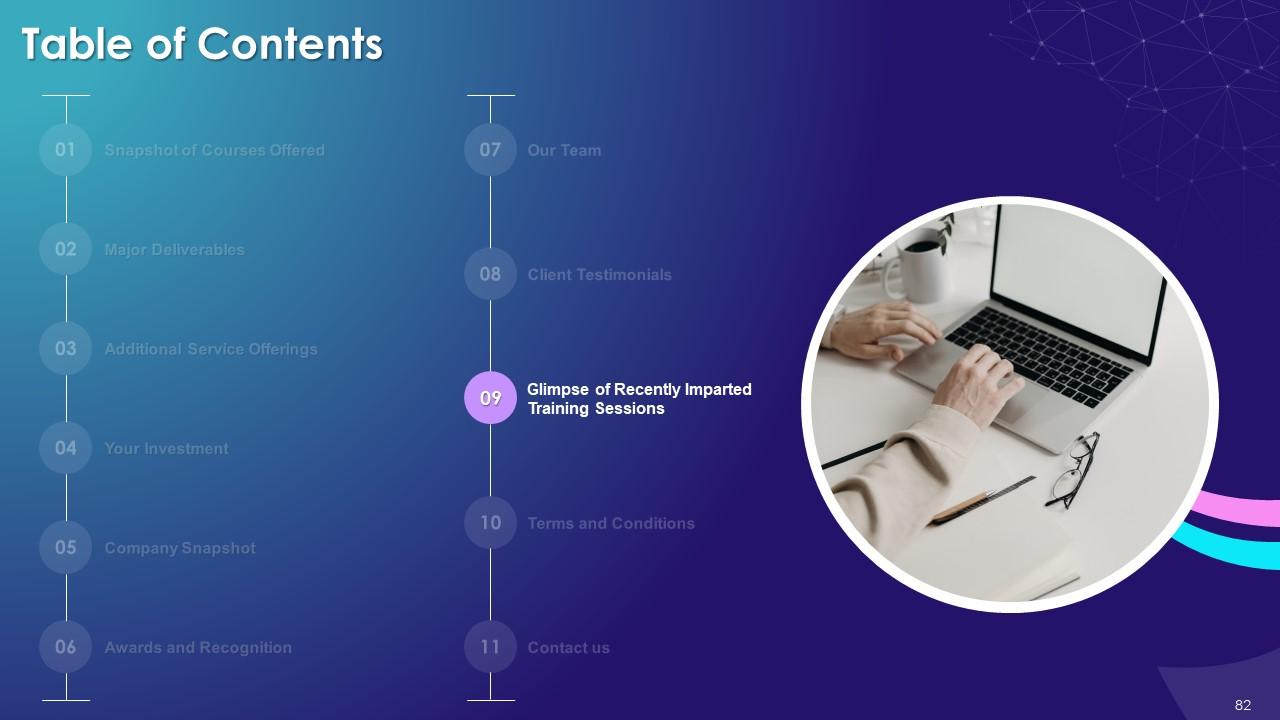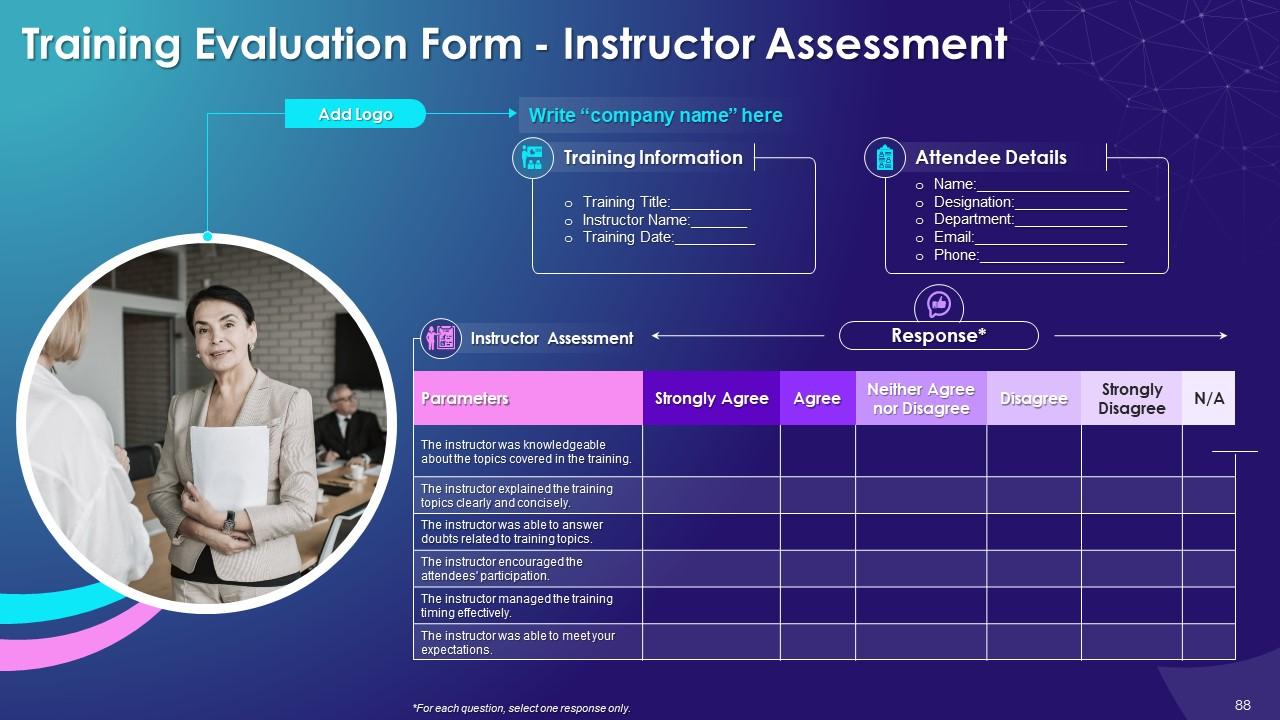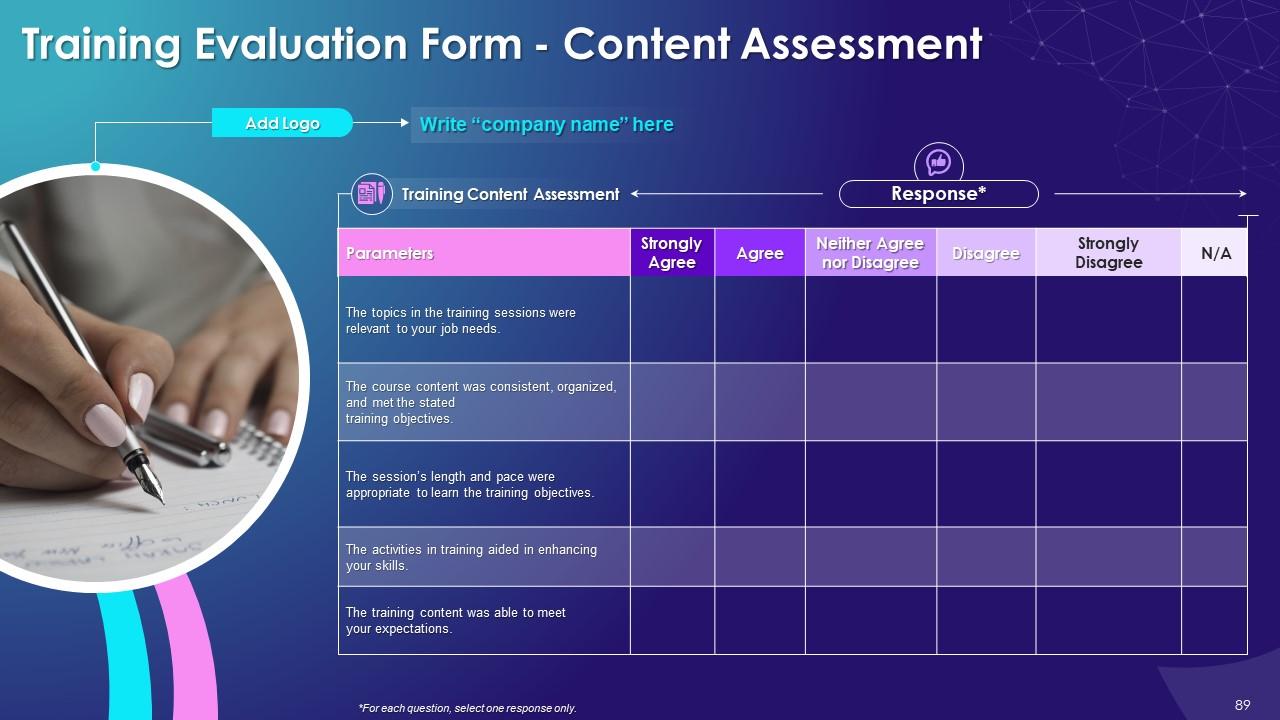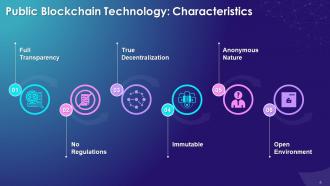Training Module on Different Types of Blockchain Training Ppt
This PPT training deck covers the characteristics, advantages, and disadvantages of the public, private, consortium, and hybrid blockchain types. It also compares these on factors such as centralization, immutability, speed, energy consumption, security, and the possibility of a 51 percent attack. The PowerPoint module also contains key takeaways, discussion, and multiple-choice questions related to the topic to make the training session interactive. Further, it contains additional slides on about us, vision, mission, goal, 30-60-90 days plan, timeline, roadmap, training completion certificate, energizer activities, detailed client proposal, and training assessment form.
This PPT training deck covers the characteristics, advantages, and disadvantages of the public, private, consortium, and hy..
- Google Slides is a new FREE Presentation software from Google.
- All our content is 100% compatible with Google Slides.
- Just download our designs, and upload them to Google Slides and they will work automatically.
- Amaze your audience with SlideTeam and Google Slides.
-
Want Changes to This PPT Slide? Check out our Presentation Design Services
- WideScreen Aspect ratio is becoming a very popular format. When you download this product, the downloaded ZIP will contain this product in both standard and widescreen format.
-

- Some older products that we have may only be in standard format, but they can easily be converted to widescreen.
- To do this, please open the SlideTeam product in Powerpoint, and go to
- Design ( On the top bar) -> Page Setup -> and select "On-screen Show (16:9)” in the drop down for "Slides Sized for".
- The slide or theme will change to widescreen, and all graphics will adjust automatically. You can similarly convert our content to any other desired screen aspect ratio.
Compatible With Google Slides

Get This In WideScreen
You must be logged in to download this presentation.
PowerPoint presentation slides
Presenting Training Session on Different Types of Blockchain. This presentation deck contains 90 well researched and uniquely designed slides. These slides are 100 percent made in PowerPoint and are compatible with all screen types and monitors. They also support Google Slides. Premium Customer Support available. Suitable for use by managers, employees and organizations. These slides are easily customizable. You can edit the color, text, icon and font size to suit your requirements.
People who downloaded this PowerPoint presentation also viewed the following :
Content of this Powerpoint Presentation
Slide 4
This slide illustrates the multiple types of blockchain such as public, private, consortium, and hybrid.
Slide 5
This slide illustrates the concept of public blockchain technology. It also provides information regarding the definition and examples of the public blockchain.
Slide 6
This slide illustrates the features of public blockchain technology. It also provides information regarding its characteristics such as full transparency, no regulations, true decentralization, immutable, anonymous nature, and open environment.
Instructor’s Notes:
The different characteristics of public blockchain are as follows:
Full Transparency:
- Public blockchain provides full access and allows individuals to see the ledger anytime
- Anyone can maintain the ledger and participate in consensus. This ensures that indulging in corruption is near-impossible
No Regulations:
- A public blockchain has no regulations that nodes need to follow, which leads to limitless applications of public blockchain technology
True Decentralization:
- In a public blockchain, no centralized system is involved
- It is individuals' responsibility to maintain the nodes and update the ledgers in the blockchain network
- A public blockchain has no centralized system to track activity, which gives complete freedom to join the blockchain
Immutable:
- In a public blockchain, once the data is stored then it cannot be changed
Anonymous Nature:
- In a public blockchain, all the individual identities are anonymous, and it is not required to use real names
- Individual identities stay hidden, and it is not easy to track human behind the transactions
Open Environment:
- Public blockchain is open to all and any individual can participate in it
Slide 7
This slide illustrates the benefits of public blockchain technology, such as higher security, greater transparency, decentralized structure, and user empowerment.
Instructor’s Notes:
The multiple advantages of public blockchain are as follows:
- Higher Security: A blockchain system is not easy to hack. The larger the blockchain is, the more difficult it is for anyone person or entity to influence it
- Greater Transparency: All transaction records are shared with every member of the blockchain system in a distributed digital ledger resulting in more transparency
- User Empowerment: Any person with an internet connection can download a copy of the blockchain and can participate in maintaining the ledger
Slide 8
This slide showcases the multiple limitations of public blockchain technology, such as privacy limitations, lack of regulations and governance, public perception, cost of setup, and huge consumption of energy.
Instructor’s Notes:
The different challenges of public blockchain are as follows:
Privacy Limitations:
- Total security in the public blockchain is a tricky concept
- Data in the public blockchain is secure as long as it is not single-handedly controlled/influenced by some individual/entity
- The moment only one entity can unduly influence public blockchain data, the system loses its security. This is a logical possibility in newer or smaller blockchains
Lack of Regulations and Governance:
- The essential feature of Blockchain Technology is that it lacks regulatory oversight
- It allows peer-to-peer transactions, which leads to cutting off intermediaries
- It does not require governance from statutory bodies
- No one can be held accountable for maintaining the network standard, thus adding an element of skepticism to the entire system
Public Perception:
- Lack of supportive public perception is a significant hurdle to blockchain success
- Popular public opinion towards blockchain is that it is not a sustainable technology
- Features like lack of governance, easy access to public blockchain membership, and lack of regulation add to the unreliable public image of the blockchain technology
Cost of Set-Up:
- Establishing the entire blockchain Technology system is expensive due to:
- High set-up cost
- Limited skilled talent
- Training costs
Huge Consumption of Energy:
- Blockchain's energy consumption for a cryptocurrency exchange is an important area of concern
- The Proof-of-Work mechanism consumes a lot of energy while solving complex mathematical problems
Slide 10
This slide illustrates the concept of private blockchain technology. It also provides information regarding the introduction, and examples of the private blockchain.
Slide 11
This slide illustrates the characteristics of private blockchain technology such as access, high transaction rate, security, and consensus algorithms.
Instructor’s Notes:
The different characteristics of private blockchain are as follows:
Access:
- Private blockchains are permissioned blockchains. Read and write can be done only by permissioned nodes
Higher Transaction Rate:
- In a private blockchain, the transaction rate is higher (per second) per transaction than in a public blockchain
Security:
- A private blockchain is more susceptible to hacking, and data breaches
- It is easy for imperfect players to put the entire blockchain network at risk. Hence, it is less secure
Consensus Algorithms:
- Consensus can be accomplished through a process called a selective endorsement. This is based on the idea that network participants have clearance to be there and that each participant interested in a transaction can confirm it
Slide 12
This slide illustrates the characteristics of private blockchain technology such as privacy, high efficiency, and better scalability.
Instructor’s Notes:
The different characteristics of private blockchain are as follows:
Privacy:
- In a private blockchain, the primary focus is on the privacy of all individuals
- A private blockchain is more centralized, so it is easy to maintain the confidentiality of the individuals
High Level of Efficiency:
- The efficiency of the private blockchain depends upon the number of nodes in the blockchain
- In a private blockchain, only limited pre-authorized nodes are added to the system, therefore the system works with better efficiency and speed
Energy Efficient:
- In a private blockchain, the transaction of nodes is lower due to fewer participants, leading to minimal energy consumption
Better Scalability:
- Since nodes and services can be added on-demand, it is far easier to achieve scalability in the private blockchain
- Due to limited nodes, the system does not slow down which results in reduced fees and faster transactions, leading to greater scalability
Slide 13
This slide illustrates the demerits of private blockchain technology, such as trust, high energy consumption and limited security.
Instructor’s Notes:
The different disadvantages of private blockchain are as follows:
Trust:
- Trust is a substantial issue for a private blockchain
- The credibility of a private blockchain network depends on the credibility of the authorized nodes
- The nodes have to be trustworthy as they verify and validate transactions
- The validity of records can’t be independently verified in a private blockchain
Security:
- Security is another concern with a private blockchain
- Due to fewer nodes, it is easier for hackers to control the network
- In private blockchains, the risk of being hacked or having data manipulated is higher
Slide 15
This slide illustrates the concept of consortium blockchain technology. It also contains information regarding the introduction, and examples of consortium blockchain.
Slide 16
This slide illustrates the characteristics of consortium blockchain technology, such as faster speed, lower transaction costs, lower energy consumption, and no risk of 51% attack.
Instructor’s Notes:
The different characteristics of consortium blockchain are as follows:
- Faster Speed: The consortium blockchain provides a faster output compared to public blockchains. This is an improvement over public blockchains
- Lower Transaction Costs: Everything in the consortium blockchain is regulated, so the fee remains the same no matter how many users are on the network
- Lower Energy Consumption: In consortium blockchain, verification of all transactions and documents requires lower energy consumption than the public blockchain
- No-Risk of 51% Attack: The consortium blockchain offers greater degree of security and protection against the 51% attack
Slide 17
This slide showcases the benefits of consortium blockchain technology, such as control, security, and privacy.
Instructor’s Notes:
The different advantages of consortium blockchain are as follows:
Control:
- The consortium blockchain is controlled by multiple groups and is protected from monopoly
- Each member in the consortium blockchain settles and enables them to establish their own rules, change or cancel incorrect transactions, modify balances, and perform other actions
Security:
- Only selected members do validation and verification of nodes to avoid the 51% of attack
- Individuals violating rules are identified immediately and charged with penalties
Privacy:
- The information shared in the consortium blockchain is kept private and not disclosed to the public
- It creates a significant level of trust and confidence for clients of the platform
Slide 18
This slide illustrates the demerits of consortium blockchain technology, such as unstable relationships, lack of economic model, flexibility issues.
Instructor’s Notes:
The different disadvantages of consortium blockchain are as follows:
Unstable Relationships:
- In consortium blockchains, companies of different sizes, intentions, and expectations cannot work together due to data privacy concerns, which leads to instability and the failure of business relationships
Lack of Economic Model:
- Consortium chains lack tokens to motivate developers and entrepreneurs to develop and use their blockchains, thus missing out a viable economic model
Flexibility Issues:
- The process of launching the consortium blockchain is susceptible
- All members must give their approval to the protocol for communication
- Since enterprises have little flexibility in making changes independently, thus that a broad network exists between enterprises is often significantly delayed
Slide 20
This slide illustrates the concept of hybrid blockchain technology. It also delivers information regarding the introduction, and example of hybrid blockchain.
Slide 21
This slide illustrates the characteristics of hybrid blockchain technology, such as secure, transparent, immutable, and decentralized.
Instructor’s Notes:
The different characteristics of hybrid blockchain are as follows:
Secure:
- Members in hybrid blockchain technology are selected to verify nodes
- In the hybrid model, any individual violating rules is identified immediately and charged with high fines
Transparent:
- Trust is a more substantial issue for hybrid blockchain technology
- Transparency leads to trust generation in the system
- The credibility of a hybrid blockchain network depends on the credibility of the authorized nodes
- The nodes are trustworthy as they verify and validate transactions end-to-end
Immutable:
- Once data is added, it cannot be changed ensuring that the system is immutable
Decentralized:
- Hybrid blockchain technology works on the decentralization principle
Slide 22
This slide showcases the benefits of hybrid blockchain technology, such as works in closed ecosystem, flexibility in changing rules, protection from 51% attack, protecting privacy, and lower transaction cost.
Instructor’s Notes:
The different advantages of hybrid blockchain are as follows:
Works in Closed Ecosystem:
- Hybrid blockchain works in a closed ecosystem so organizations need not worry about critical information being leaked when working with hybrid blockchain technology
Flexibility in Changing Rules:
- In the hybrid blockchain, technology changes can be done as one organization has control over the entire blockchain
Protecting from 51% Attack:
- Hybrid blockchain is immune to a 51% attack as hackers cannot access the network to carry out the attack in the blockchain
Protecting Privacy:
- Hybrid blockchain helps to connect with the outside world ensuring that parent organization data remains secure
Lower Transaction Cost:
- In hybrid blockchain technology, lower number of nodes lead to lower transaction cost
- The transaction cost can reduce to even 0.01$ per transaction
- Powerful nodes in the network make it easy to verify the transaction
Slide 23
This slide illustrates the demerits of hybrid blockchain technology, such as lack of transparency and limited scalability.
Instructor’s Notes:
The different disadvantages of hybrid blockchain are as follows:
- Lack of Transparency: In the hybrid blockchain, transparency in sharing of information is missing, and information can also be shielded
- Limited Scalability: The scalability of hybrid blockchain is difficult as participants are not motivated to participate or contribute to the network
Slide 25
This slide illustrates the comparison between public vs. private blockchain technology. They are compared on parameters like immutability, energy efficiency, speed, energy consumption, and security.
Slide 26
This slide illustrates the comparison between public, private, and consortium blockchain on multiple parameters such as centralization, permission, immutability, energy efficiency, speed, energy consumption, security, and the possibility of 51% attack.
Slide 27
This slide illustrates the comparison between public, private, hybrid, and consortium blockchain on the basis of advantages, disadvantages, and use cases.
Slide 29
This slide depicts the summary of the blockchain types training session. The trainer can use it to highlight the essential concepts of the session to trainees.
Slide 45 to 59
These slides contain energizer activities to engage the audience of the training session.
Slide 61 to 87
This slide highlights the cover letter for the training proposal. It includes details regarding what the company providing corporate training can accomplish for the client.
Slide 88 to 90
This slide highlights the training evaluation form for instructor assessment. It also includes sections to fill details of training information and attendee details.
Training Module on Different Types of Blockchain Training Ppt with all 95 slides:
Use our Training Module on Different Types of Blockchain Training Ppt to effectively help you save your valuable time. They are readymade to fit into any presentation structure.
-
I want to thank SlideTeam for the work that they do, especially their customer service.
-
The designs are super attractive. Me and my team love using SlideTeam’s presentations.



